
annualreportand businessresourceguide
UTAH GOVERNOR’S OFFICE of ECONOMIC DEVELOPMENT 2010
Contents Governor’s Office of Economic Development Mission . . . . . . . . . . . . . . . . . . . . .2 Letter from the Executive Director . . . . . . . . . . . . . . . . . . . . . . . . . . . . . . . . . . . . .3 GOED Board Members . . . . . . . . . . . . . . . . . . . . . . . . . . . . . . . . . . . . . . . . . . . . . .4 Governor’s Office of Economic Development (GOED) Programs . . . . . . . . . . .5 Targeted Economic Clusters . . . . . . . . . . . . . . . . . . . . . . . . . . . . . . . . . . . . . . . .7 Business Resource Centers: Entrepreneurial Development . . . . . . . . . . . . . .13 Centers of Excellence (COE) . . . . . . . . . . . . . . . . . . . . . . . . . . . . . . . . . . . . . . .15 Corporate Recruitment and Incentives . . . . . . . . . . . . . . . . . . . . . . . . . . . . . .19 Office of Consumer Health Services . . . . . . . . . . . . . . . . . . . . . . . . . . . . . . . . .23 International Trade and Diplomacy . . . . . . . . . . . . . . . . . . . . . . . . . . . . . . . . .27 Pete Suazo Utah Athletic Commission . . . . . . . . . . . . . . . . . . . . . . . . . . . . . . .29 Procurement Technical Assistance Centers (PTAC) . . . . . . . . . . . . . . . . . . . .31 Rural Development . . . . . . . . . . . . . . . . . . . . . . . . . . . . . . . . . . . . . . . . . . . . . . .33 State Science Advisor . . . . . . . . . . . . . . . . . . . . . . . . . . . . . . . . . . . . . . . . . . . . .37 Utah Broadband Mapping, Analysis and Planning Project . . . . . . . . . . . . . . .39 Utah Film Commission . . . . . . . . . . . . . . . . . . . . . . . . . . . . . . . . . . . . . . . . . . .41 Utah Office of Tourism . . . . . . . . . . . . . . . . . . . . . . . . . . . . . . . . . . . . . . . . . . .45 West Coast Initiative . . . . . . . . . . . . . . . . . . . . . . . . . . . . . . . . . . . . . . . . . . . . . .49 Governor’s Office of Economic Development Partners . . . . . . . . . . . . . . . . . .53 Economic Development Corporation of Utah (EDCUtah) . . . . . . . . . . . . . .55 Manufacturing Extension Partnership . . . . . . . . . . . . . . . . . . . . . . . . . . . . . . .57 Small Business Development Centers (SBDC) . . . . . . . . . . . . . . . . . . . . . . . .61 UGREEN . . . . . . . . . . . . . . . . . . . . . . . . . . . . . . . . . . . . . . . . . . . . . . . . . . . . . . .65 Utah Fund of Funds . . . . . . . . . . . . . . . . . . . . . . . . . . . . . . . . . . . . . . . . . . . . . .67 Utah Science Technology and Research Initiative (USTAR) . . . . . . . . . . . . . .69 Utah Sports Commission . . . . . . . . . . . . . . . . . . . . . . . . . . . . . . . . . . . . . . . . . .73 World Trade Center Utah . . . . . . . . . . . . . . . . . . . . . . . . . . . . . . . . . . . . . . . . . .77 Economic Development Resources . . . . . . . . . . . . . . . . . . . . . . . . . . . . . . . . . . . .79 Business Resource Center’s Contacts . . . . . . . . . . . . . . . . . . . . . . . . . . . . . . . .81 Procurement Technical Assistance Centers Contacts . . . . . . . . . . . . . . . . . . .82 Economic Development Contacts by County . . . . . . . . . . . . . . . . . . . . . . . . .83 GOED Contacts . . . . . . . . . . . . . . . . . . . . . . . . . . . . . . . . . . . . . . . . . . . . . . . . .85 Organizational Chart . . . . . . . . . . . . . . . . . . . . . . . . . . . . . . . . . . . . . . . . . . . . . . .87
Mission Statement
Utah will excel in job creation, innovation, entrepreneurship, global business, and quality workforce and have a stable and sustainable business friendly environment.
GOED is organized into three business units:
CREATE
•Wor ks to identify and leverage specific industries and business environments, or “clusters,” where Utah has competitive advantages.
•Assists emerging companies and encourages development of Utah’s physical infrastructure, and facilitates networking, access to human capital and financing sources.
GROW
•Focused on retention and expansion of existing Utah companies, and the recruitment and relocation of new companies to the State.
GOED Values
• Integrity
• Drive change & continuous improvement
• Teamwork & cooperation
• Be the best at what we do, and partner for success
• To maintain the momentum of Utah’s “Dynamic Economy”
•Utilizes incentives to co mpanies, in the form of postperfor mance gr ants and tax credits, which are cont ingent upon the creation of new jobs and the generation of new state tax revenue. Incentives are post-performance, disbursements made only after the company meets contractual performance metrics.
•Incentives for film production have also become a determining factor in building the economic base of the Utah film industry.
•Through the International Trade and Diplomacy Office, conducts activities such as trade missions to encourage expansion of international business opportunities for Utah companies and attract foreign investment.
PROMOTE
•Focused on publicizing Utah to key domestic and international markets through trade shows, sales missions and familiarization tours.
•Promoting Utah helps the Create and Grow programs by raising the positive Utah profile which attracts new businesses to the State and assists Utah companies as they seek to market new technologies, increase international trade and generate economic activity.
2 Governor’s Office of Economic Development • Annual Report 2010 • www.business.utah.gov
State of Utah
GARY R. HERBERT Governor
GREG BELL Lieutenant Governor
Governor’s Office of Economic Development
SPENCER P. ECCLES Executive Director
Dear Legislator and Business Leader:
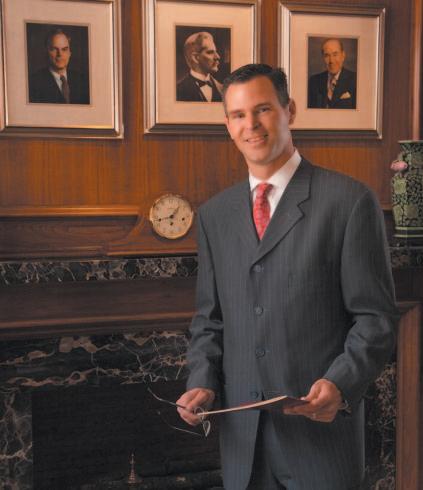
In his economic plan, Governor Gary R. Herbert reiterated his vision for our great State of Utah: Utah will lead the nation as the best performing economy and be recognized as a premier global business destination.
The team at the Governor’s Office of Economic Development (GOED) is committed to making this v ision a reality. A year ago, the Governor directed our office to focus on four objectives:
1.Strengthen and grow existing Utah businesses, both urban and rural.
2.Increase innovation, entrepreneurship and investment.
3.Increase national and international business.
4.Prioritize education to develop the workforce of the future.
In the spirit of “unprecedented partnerships,” we continue to work closely with our Board, the business community, the Legislature, state agencies, city and county officials, academia and other economic development partners on accomplishing the four objectives. I have seen many examples of how Utah’s key stakeholders work together to move the State forward and I consider it Utah’s ‘secret sauce’ for success.
Our team has redesigned this Annual Report for FY 2009 – 2010 to serve as a report and a convenient resource guide. It is a small example of how we are working to make our team more accessible.
I remain confident that innovative, entrepreneurial and hard working Utahns will continue to strengthen Utah’s economy. Utah is poised to lead and we look forward to working with you.
Thank you,
Spencer P. Eccles Executive Director
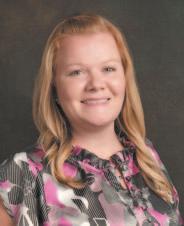
To contact the Executive Director about GOED visit www.business.utah.gov or contact Sue Redington, Executive Assistant to Spencer P. Eccles at sredington@utah.gov or 801-538-8769.
3
Office of Economic Development
Annual Report 2010
www.business.utah.gov
Governor’s
•
•
GOED Board Members

Jerry Oldroyd Ballard SpahrAndrews & Ingersoll
Term End: March 2011
Salt Lake City
Incentives Committee
Oldroyd is a partner in the Business & Finance Department and Communications Group, and a trustee of Utah Technology Council.

Ragula Bhaskar Fatpipe Networks, Inc.
Term End: March 2011
Salt Lake City Incentives Committee
Dr. Ragula Bhaskar is President and CEO of FatPipe Networks, the inventor of patented router-clustering technology.
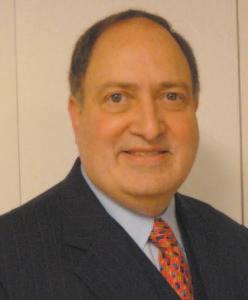
Clifford D. White Capital Consultants
Term End: March 2011
Salt Lake City
Businessman, Investor and Financial Planner. Active in Utah community service for 42 years.

Amy Rees Anderson Mediconnect
Term End: 2013 Sandy Amy is the CEO of Mediconnect Global, Inc. In 2007, Amy received the Ernst & Young Entrepreneur of the Year Award and she was featured on the cover of Inc Magazine for the 2007 Inc 500.

Peter Mouskondis
Nicholas & Company
Term End: 2013 Salt Lake City
Westminster College Foundation Board Member, IFDA Board Member, Independent Marketing Alliance Board Member, and Markon Board Member.

Jack Brittain VP Technology Venture
Term End: 2013 Salt Lake City
Jack Brittain, Ph.D. is the U.’s Tech Ventures VP. Tech Ventures commercializes U. technologies and ranks second to MIT in number of spinoffs per year.
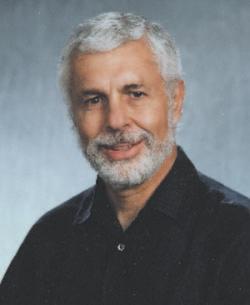
Mel Lavitt Needham and Company, LLC
Term End: 2013 Park City
Incentives Committee
Lavitt’s career in investment banking has included hundreds of capital market transactions accounting for several billion dollars of equity and debt financing.
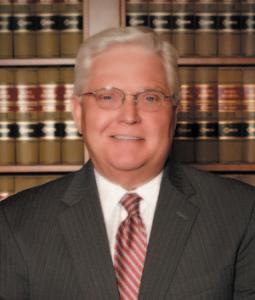
V. Lowry Snow
Jensen & Reece
Term End: 2013
St. George Board member of the Washington County Econ Dev. Council, InterLinx Comm., Tonaquint Data Center, and Southern Utah Community Legal Center.

Mike Dowse Amer Sports
Term End: March 2011 Ogden
Incentives Committee
Dowse is the President of Amer Sports Winter & Outdoor Americas (Ogden). He prevously worked for Suunto, Nike, and Wilson.
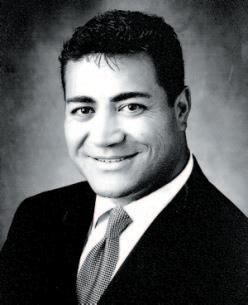
Molonai Hola
Icon Consulting Group
Term End: 2013 Salt Lake City Incentives Committee
Hola is President and CEO of Icon Consulting Group. Thunderbird International Business School Graduate with a Master’s in International Management.
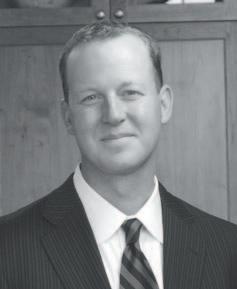
Jake Boyer
The Boyer Company
Term End: 2013 Salt Lake City
President of The Boyer Company. Managed the Gateway Project, a $375 million, 2.1 million square foot development in Salt Lake City.
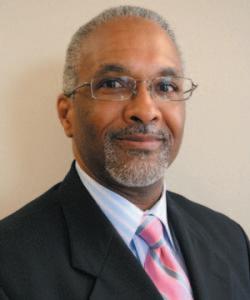
Stanley Ellington Utah Black Chamber of Commerce
Term End: March 2011
Salt Lake City
Retired administrator from the United States Air Force. Executive Director of the Utah Black Chamber of Commerce and Chair of United 4 Economic Development.
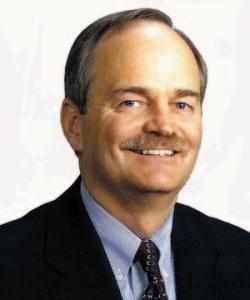
Rob Adams
E.D. Beaver County Econ Development Corp
Term End: 2013 Beaver
Currently serves as the Executive Director for the Beaver County Economic Development Corporation. Rob is a licensed real estate broker with Coldwell Banker.
4 Governor’s Office of Economic Development • Annual Report 2010 • www.business.utah.gov

PROGRAMS
PROGRAMS
The Governor’s Office of Economic Development oversees the following programs:
Targeted Economic Clusters
Business Resource Centers: Entrepreneurial Development
Centers of Excellence (COE)
Corporate Recruitment and Incentives
Office of Consumer Health Services
International Trade and Diplomacy
Pete Suazo Utah Athletic Commission
Procurement Technical Assistance Centers (PTAC)
Rural Development
State Science Advisor
Utah Broadband Mapping, Analysis and Planning Project
Utah Film Commission
Utah Office of Tourism
West Coast Initiative
6 Governor’s Office of Economic Development • Annual Report 2010 • www.business.utah.gov
OVERVIEW
Clusters are groups of related businesses and organizations within industry whose collective excellence, collaboration and knowledge base provide a sustainable competitive advantage. Strong Clusters translate directly into tangible benefits for Utah’s businesses, citizens and educational institutions. In Clusters, businesses have shared access to suppliers, services, resources, technology and workforce. In addition, related businesses work together to achieve new economies of scale, distribution channels and, ultimately, increased profitability.
The Governor’s Office of Economic Development (GOED) established the Economic Clusters Initiative as a catalyst to focus people, ideas and resources on our greatest opportunities for success. The initiative allowed us to align industry, research universities, capital, talent, technology and government around emerging or mature industry sectors that possess the greatest sustainable competitive advantage. The net effect is these factors combine to create higher paying jobs, strengthen education and raise the standard of living in Utah.
Cluster Goal: Make Utah a hypercompetitive region in targeted economic clusters by focusing on industry sectors which have the best outlook for growth and create high paying jobs.
TARGETED ECONOMIC CLUSTERS
Focused development on emerging Utah industry strengths:
Aviation & Aerospace
• Advanced Composites
• Aircraft Maintenance, Repair & Overhaul
Defense & Homeland Security
• Unmanned & Autonomous Vehicles
• Logistics and Distribution
Energy & Natural Resources
• Renewable Energy
Financial Services
Life Sciences
• Medical Devices
• Biotechnology
• Natural Products

Outdoor Products & Recreation
• Cycling
Software Development & Information Technology
• Digital Media
7 Governor’s Office of Economic Development • Annual Report 2010 • www.business.utah.gov
geted Economic Clusters
Tar
Economic Clusters Highlights for FY2010
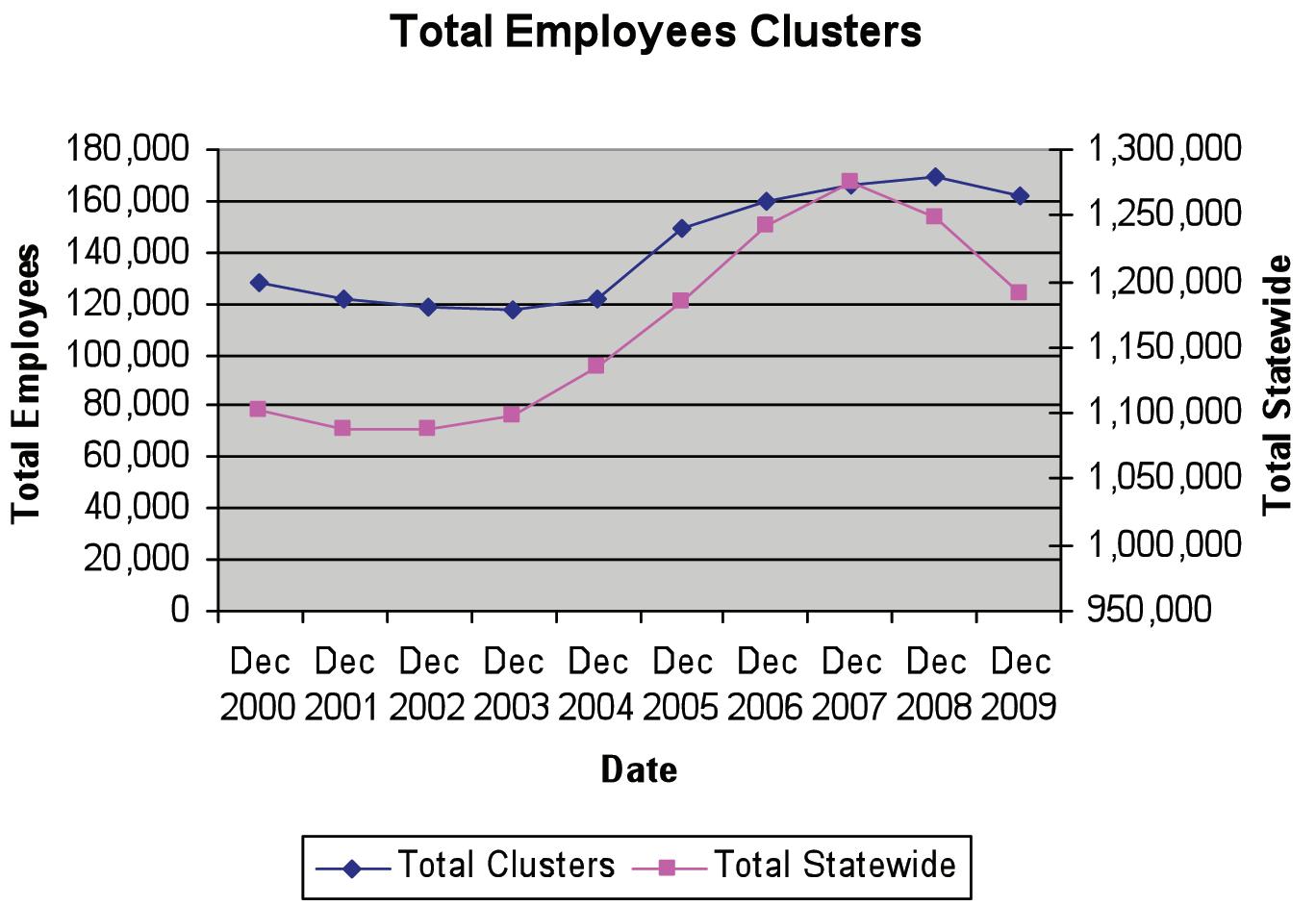
• Cluster related industries employ 161,652 (8.1% growth since 2005 compared to overall employment in Utah which grew 0.5% during the same period)
– Life Sciences and Defense industries are most resilient last three years
– The Software and IT Cluster returned to pre-dot.com bust levels
• The average wage earned by an employee in a cluster-related industry is 62% higher that the state average monthly salary
Life Sciences
• Life Science Industry employs almost 25,000 personnel across the State, and accounts for 2.1% of all employees in Utah, up from 1.9% in 2005.
• Life Sciences is the most resilient of the cluster industries with continued growth, even through the recent economic difficulties. Cluster grew at a 10% rate since 2005, adding 800 employees last year.
Utah and its life science companies participated in the 2010 Biotechnology Industry Organization (BIO) International Convention. The Utah pavilion dem-
8 Governor’s Office of Economic Development • Annual Report 2010 • www.business.utah.gov
Tar geted Economic Clusters
onstrated to the international biotechnology community that the life sciences are a critical component of the dynamic economic environment in Utah.

U tah continues to leverage the Wo rkforce Innovation and Regional Economic Development (WIRED) $5 million grant awarded from the U.S. Department of Labor. Over 89,000 students participated in one or more of the initiative’s programs last year. The activities of this grant are focused on creating education programs that help provide a wellqualified workforce for the Life Science Industry.
In the Fall of 2009, the BioInnovation Gateway (BiG) began operations as a life science workforce development and business incubator. This very unique effort, funded through the WIRED initiative, is a joint venture between USTAR and the Granite Technical Institute with students getting hands-on experience with life sciences companies.
Utah’s Natural Products and Dietary Supplement Industry is recognized as a national leader (25% national market share) , with estimates of representing seven billion dollars in sales. GOED is helping to coordinate activities that assist this dynamic industry. Efforts this past year focused on responding to the industry’s request for safety testing of raw materials and workforce development.
Av iation and Aerospace
Completed an Aerospace Utah Cluster Acceleration Partnership in coordination with industry, Department of Workforce Services, Utah System of Higher Education, USTAR and facilitated by Grow Utah Ventures. The effort identified opportunity areas for growth in the sector, education and workforce needs and ways to continue to grow the industry. Utah is known for and has opportunities for growth in Maintenance, Repair and Overhaul of both military and commercial aircraft, advanced composites and materials, unmanned aerial systems and space technology.
Defense and Homeland Security
The Defense and Homeland Security Cluster sector continues to be strong in the state, employing almost 45,000 Utahans through its many functions, both on the various military installations across the state and by defense contractors.
•Hill Air Force Base (HAFB) remains the largest single site employer in the state w ith almost 22,000 employees working on the base every day.
9 Governor’s Office of Economic Development • Annual Report 2010 • www.business.utah.gov
geted Economic Clusters
Tar
Tar geted Economic Clusters
•The Air Force’s new fighter, the F-35 Joint Strike Fighter, will have a significant impact on Utah as it enters the force over the next decade or two. ATK and other defense contractors are conducting significant workload associated with the program, employing hundreds across the State. As part of the JSF, Janicki Industries, a national leader in precision tooling for the advanced composites industr y, is expanding into Utah to support JSF production.
•Hill Air Force Base was selected for F-35 Joint Strike Fighter maintenance of this next generation Air Force fighter, which will replace the F-16 that Hill AFB currently maintains.
•Hill Air Force Base was selected by the Air Force as their preferred choice to have an operational wing of F-35 Joint Strike Fighters stationed there, contingent on the completion of an environmental process that could result in 72 F-35s being based at Hill beginning in 2013.
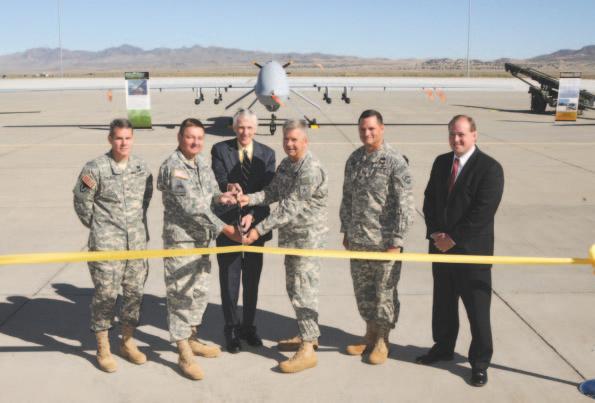
•Unmanned Vehicle activity within the State continues to grow with the Army standing up its Rapid Integration and Acceptance Center at Dugway Proving Ground. Over 350 jobs will be created by this and related activities. The State has been contacted by several defense contractors who are interested in opening unmanned vehicle operations in Utah due to the attributes of this growing industry.
Energy
•Includes generation, production, transmission, sale and consumption of traditional (oil, gas and coal) and alternative (including renewable energy and energy efficiency) energy sources, mineral technology and transmission
•Cluster industries invested $1.38B in total wages (38.7% growth between 2005 and 2009), paying 165.6% of state monthly average wage (December 2009), and established 1,142 new energy companies (9.7% increase between 2005 and 2009).

•Utah established the Renewable Energy Development Incentives (REDI) effort, a refundable tax credit of up to 100% of new state taxes for the life of a project, to companies to locate in the state who manufacture renewable energy (biom-
10 Governor’s Office of Economic Development • Annual Report 2010 • www.business.utah.gov
ass, geothermal, hydroelectric, solar, and wind) components or who generate utility-scale renewable energy.
•The state established the Utah Generated Renewable Energy Electricity Network Authority (UGREEN) to oversee and develop transmission corridors for renewable energy generation sites to deliver power to consumers.
•Utah has huge potential development opportunities: 9,145 MW of wind, 826 GW of solar and 1,330 MW of geothermal power.
•Utah is one of only four states generating power from geothermal sources
“Simply put, few other states have the energy resources with which we, in Utah, have been blessed,” said Utah Gov. Gary R. Herbert in his 2010 State of the State Address in January. In his address, Gov. Herbert also announced The Utah Energy Initiative; a 10-year plan to ensure Utah’s continued access to its own low-cost energy resources, and its ability to be on the cutting edge of new energy technologies.
• GOED formed an Energy Working Group (EWG) for the State, which meets monthly, to help facilitate coordination, awareness and understanding for state agencies and their partners related to energy and economic development opportunities
• GOED created the Military Installation Energy Collaborative (MIEC) to coordinate energy opportunities with the military installations who have strategic goals set by the Department of Defense for energy reduction and independence
Digital Media
•Utah’s Digital Media Industry has companies that create the media content for films, television, video games, computers, simulations and modeling, employing over 1,500 people in sixty media firms statewide.

•Some of the largest names in the industry have a presence in Utah and include Entertainment Arts, Disney Interactive Studios, Sandman Studios, Move Networks and SpectrumDNA.
• USTAR established a Digital Media Institute at the University of Utah which will enhance the development of technological advances in the digital media field through computer graphics, engineering and software development. The University of Utah is where the basic computer graphics were created that eventually became Pixar.
11 Governor’s Office of Economic Development
Annual Report 2010
www.business.utah.gov
•
•
Tar geted Economic Clusters
Tar geted Economic Clusters
•Almost 500 people from across the State participated in the Pushbutton Summit, held Spring 2010, which was the first digital media industry-wide event in Utah. The event showcased Utah’s digital media industry, future opportunities and networking events.
Outdoor Products and Recreation
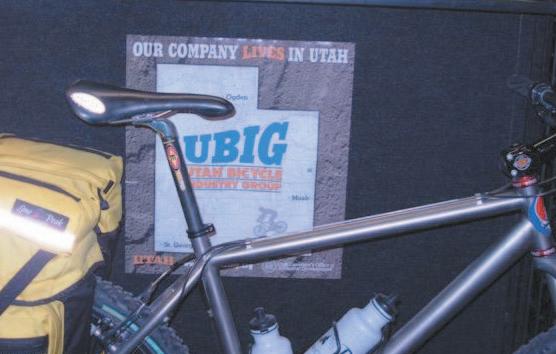
•The Outdoor Products and Recreation cluster continues to grow. The list of Utah outdoor companies include; Amer, Rossignol, Voile, Salomon, Black Diamond, Petzl, Lizard Skins, Specialized, Quality Bicycle Products.

•In the past year Specialized Bicycle Products and Black Diamond expanded; Ortovox and Quality Bicycle Products moved distribution centers to Utah, and new companies like Waterbox and Ibert started.
•The annual Outdoor Retailer Summer and Outdoor Retailer Winter Shows continue to attract vendors and retailers from around the world to Utah, and gives us an opportunity to highlight both our industry and Utah as a great place for business.
•Utah Bicycle Industry Group, started this past year, along with the Tour of Utah bicycle stage race promote Utah as a destination for bicycle businesses and bicyclists.
•“Utah’s Own,” a successful marketing of agriculture products produced in Utah has expanded to include the outdoor businesses and products that are owned, operated, and manufactured in Utah. This will help “brand” Utah as a good place to do business and as a state that produces quality products.
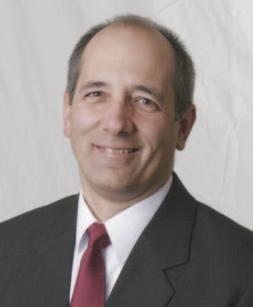
For additional information about Targeted Economic Clusters
visit www.business.utah.gov or contact Gary Harter, Managing Director, at gharter@utah.gov or 801-538-8784.
12 Governor’s Office of Economic Development • Annual Report 2010 • www.business.utah.gov
Business Resources Centers: Entrepreneurial Development
OVERVIEW
Business Resource Centers consolidate various business service providers in a single location so that business owners have only one place to go to answer most of their questions. Questions abound on business planning, tax structure, personnel, training, marketing, locations, contracting, administrative services, mentoring, and funding, funding and funding. The business resource center staff assists in coordinating the services of the local business service provider partners to make the delivery of the counseling and assistance more effective for the business customer, ensuring the business owner and managers receive all the help they need to be successful. The first thing that happens once the business customer comes through the door or makes a phone call is that the center personnel conduct an assessment discussion to understand the business owner’s needs and set-up appointments to see the various service providers who can best assist the business customer. The center personnel then conduct follow-up to ensure the customer has seen all needed providers, reach out as necessary across the State for other services and measure the success of the delivery of all services.
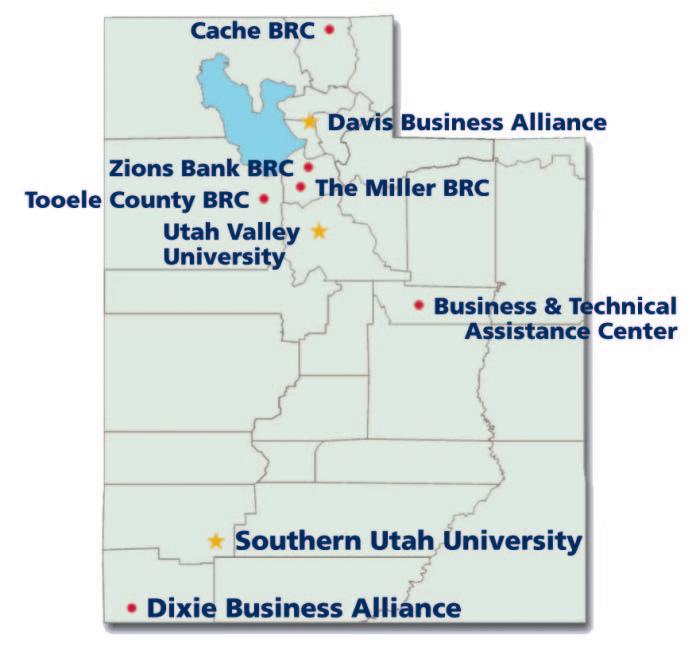
Business Resource Centers are tailored to the local community they serve and have service providers as partners who are experts in their fields to provide the answers to the business customer. Some of the partners found at the BRCs include the Small Business Development Center which is sponsored by the U.S. Small Business Administration, the Procurement Technical Assistance Center which provides governmental contracting assistance, Manufacturers Extension Partnership, Service Corps of Retired Executives (SCORE), USTAR, investors, micro loan organizations, business incubators, chambers of commerce, local economic development organizations and resources available at the local educational sponsor.
13 Governor’s Office of Economic Development • Annual Report 2010 • www.business.utah.gov
Business Resources Centers: Entrepreneurial Development
For an idea of their current impact, over 1,000 unique business customers visited the BRCs creating or retaining hundreds of jobs and starting 88 businesses. In addition, over 2,000 business personnel visited all of the business partners operating out of the BRCs.
Currently there are eight Business Resource Centers (BRC) operating across Utah
• Cache BRC at the Bridgerland ATC in Logan
• North Front BRC at the Davis Applied Technology College in Kaysville
• Miller BRC at the Miller Campus of Salt Lake Community College in Sandy
• Utah Valley University BRC in Orem
• Southern Utah University BRC in Cedar City
• Dixie BRC in St. George
• Carbon & Emery BRC in Price
• Zions BRC in Salt Lake City

For additional information about Business Resource Centers visit www.business.utah.gov or contact Riley Cutler, Director of Outdoor Products, at crcutler@utah.gov or 801-538-8873.
14 Governor’s Office of Economic Development • Annual Report 2010 • www.business.utah.gov
OVERVIEW
The purpose of the Centers of Excellence Program is to accelerate the commercialization of promising technologies that have strategic value for Utah. The program provides grant funding for companies which license technology developed at Utah’s colleges and universities, to help accelerate the commercialization process. The process is a competitive annual selection process with grants of up to $100,000 in the first year of participation and, in a second year, up to the remainder of $500,000 total over two years of funding.
The end goal of the COE Program is to help drive economic development and job creation.
For the 2009-10 fiscal year, the Centers of Excellence Program had a budget of $2.5 million and received proposals from 28 companies which are licensees of a technology developed at one of Utah’s colleges or universities. Requested funding totaled over $5 million. Of the proposals received, 13 were in the category of Manufacturing, Materials, Energy and Environmental technologies, 12 were in the Life Sciences category, and 3 were from the Information Technology industry. The number of IT proposals was notably low, in past years the program received 12 or 13 IT proposals, or about 1/3 of total proposals. Of the total 28 proposals, 17 were new proposals to the program, and 11 were second year proposals, from Licensees which had received funding the prior year.
Of the 28 proposals, 13 were awarded funding totalling $2.46 million. Of this funding approximately $2.158 million was awarded directly to the companies and $301,000 was contracted to a university to advance research in support of the company. This partnership helps smooth the transitions of these advanced technolog ies out of the lab and into industry.
All Licensees are required to provide appropriate matching funds. Of the 13 teams awarded funding, all 13 properly executed their contracts. This was a very difficult year to raise matching funds due to the ongoing recessionary economy. Unlike in previous years, companies submitted multiple invoices during the year to claim portions of their matching funds, as they “dribbled” in. Only a few teams used investor funding (equity) as their match, most used either sub-licensing agreements or Federal SBIR or STTR funds to serve as their match for the COE funding. Although we expect all companies to receive their funding, as of the end of the fiscal year, there are still a number whose invoices are still pending final match. This year, matching funding was hardwon.
15 Governor’s Office of Economic Development • Annual Report 2010 • www.business.utah.gov
Centers of Excellence
Centers of Excellence
SUCCESS STORIES
Cosmas, Inc.
Cosmas, Inc. is commercializing a revolutionarily simple and inexpensive processes for manufacturing nanoparticles which was developed at BYU. The process can make an unlimited array of high-quality, well-defined metal oxide, mixed metal oxide, metal and metal alloy nanoparticles utilizing a very environmentally friendly method. The basic process involves two simple steps: mixing common dry, crystalline metal salts with dry, crystalline ammonium bicarbonate, and then heating the intermediate compound to a modest temperature (e.g., 250-300 °C). The nanoparticles crystallize and the byproducts escape as common gases that can be easily trapped. There are numerous applications for nanoparticles in areas as diverse as coatings for abrasion protection, ultraviolet radiation protection, antimicrobial and self-cleaning surfaces to active chemical applications such as rechargeable batteries, fuel cells and chemical catalysts.
The uniquely small, uniform-sized nanoparticles produced by Cosmas can be made in virtually any chemical composition can be utilized to great advantage. Industrial interest in the process is very high, as is Federal support through the SBIR and STTR programs.
Electron micrograph of 5 nanometer Nickel Oxide nanoparticles.

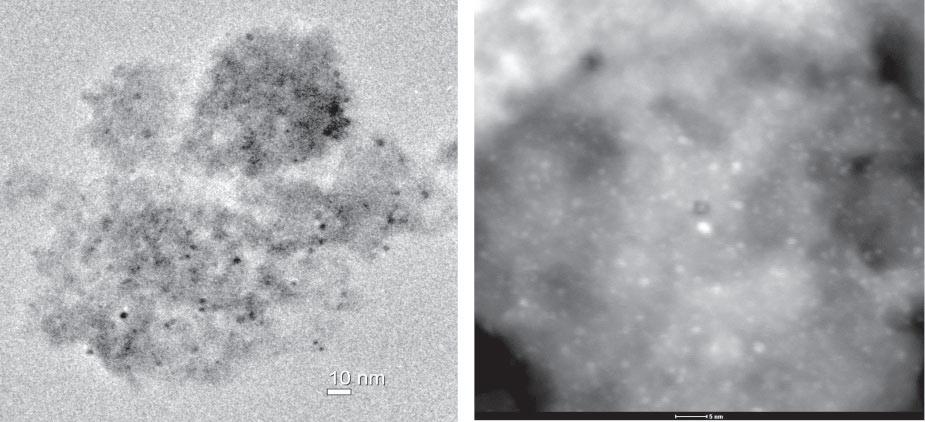
Cosmas, Inc. will place its first catalyst products with potential customers for pilot plant evaluations by the end of this fall.
Electronmicrographs of 2 nm platinum nanoparticles on aluminum oxide orous ceramic: (a) dark field image (black dots are Pt crystallites); (b) brightfield STEM image (white dots are Pt crystallites.)
The Centers of Excellence funding which Cosmas has received has made it possible for it to develop its facilities to begin scaling up the process to pilot plant levels of production for commercial applications.
16 Governor’s Office of Economic Development • Annual Report 2010 • www.business.utah.gov
iVeena, LLC
iVeena, LLC, is an early-stage biotechnology co mpany with the mission of developing a novel proprietary drug delivery device for treatment of the leading blinding diseases. iVeena will fundamentally change the way eye diseases are treated and improve the quality of life of more than 1 million people/year in the United Sates and potentially 3 million/ year worldwide by preserving their vision with its first product, the Capsule Drug Delivery Ring (CDDR).
The Challenge
Centers of Excellence
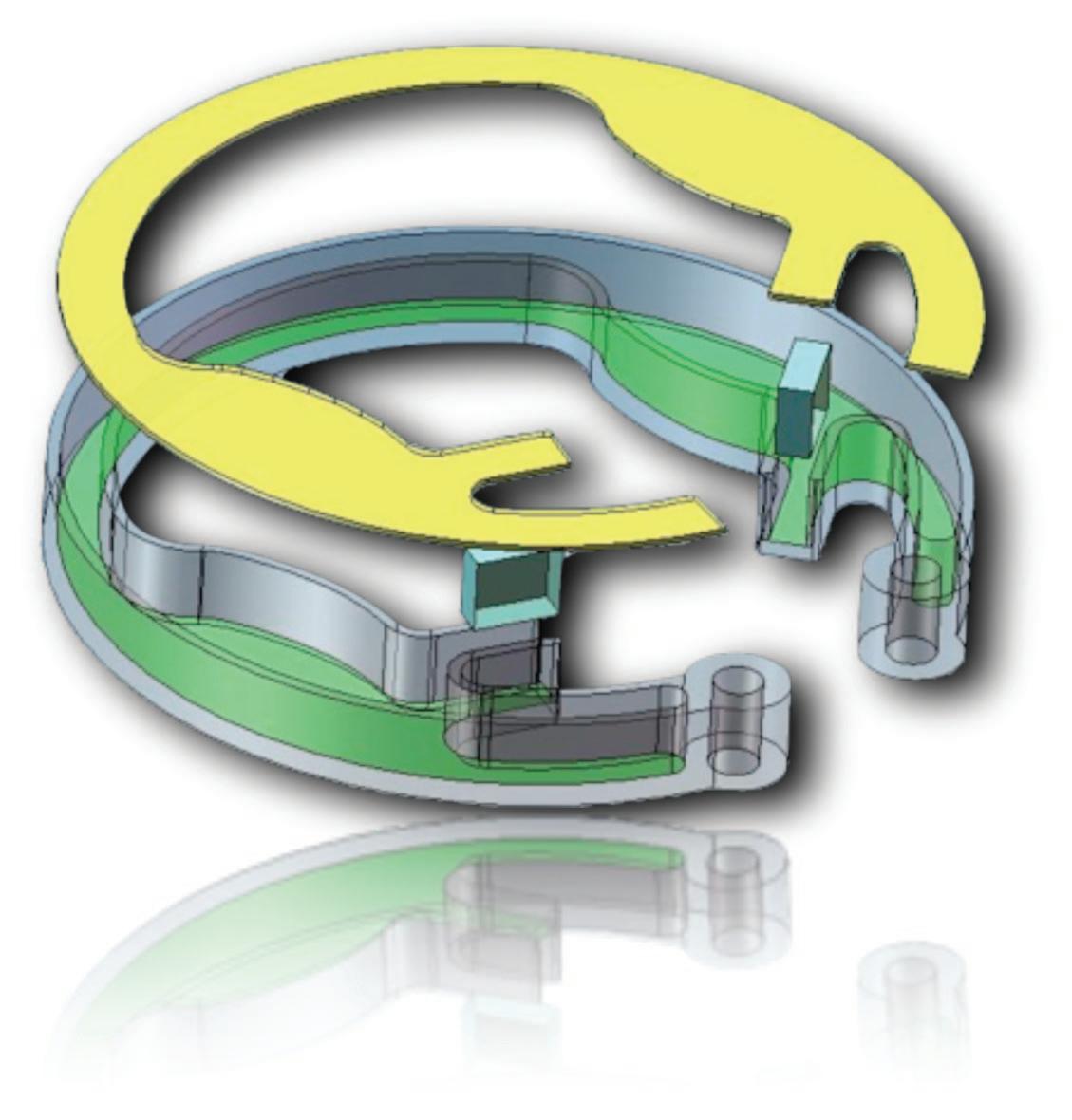
The Capsule Drug Delivery Ring or “CDDR” by IVeena, LLC.
Approximately 1 in 28 Americans over 40 is affected by low vision or blindness. Individuals who live to age 65 have a 45% risk of developing certain eye diseases (e.g. age related macular degeneration, glaucoma or diabetic retinopathy). As the >80 cohort is rapidly growing, prevalence of glaucoma and AMD are expected to more than double by 2020. To put scope to the problem over 10 million people in the United States are experiencing vision loss from AMD or are pre-symptomatic w ith vision loss in their near future. Current treatments involve complex regimes of eye drops and/or injections and are difficult for most patients. iVeena is focused on fundamentally changing the way drug administration is done in treating these diseases by inserting a “drug reservoir” inside the lens capsule of the eye for longterm therapy for the most common ocular diseases.
The Product
The Capsule Drug Delivery Ring or “CDDR” is designed such that it would sustain extended release (six months to one year) of medications thus lowering overall cost of treatment and reducing the typical high risk of permanent damage
17 Governor’s Office of Economic Development • Annual Report 2010 • www.business.utah.gov
Centers of Excellence
to v ision that is involved with eye injections. The CDDR is designed for implantation at the time of cataract surgery. Additionally, the CDDR is refillable using a disposable device allowing the CDDR to deliver drug for many years. No extra surgery would be required to implant the CDDR during a ty pical cataract surgery. In addition, the CDDR will have the advantage of using multiple chambers for simultaneous delivery of multiple drug therapies.
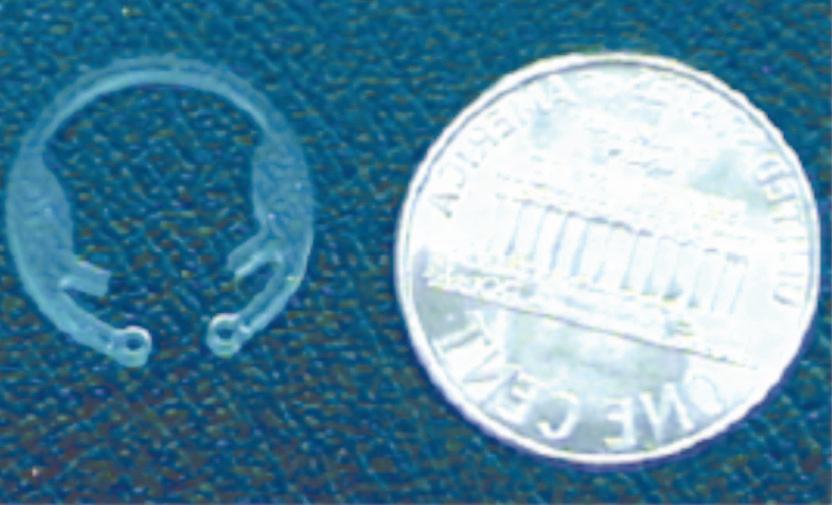
The prototype of the CDDR – an implantable ring able to hold six months to a year supply of drug therapy.
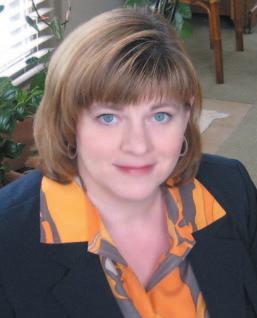
For additional information about Centers of Excellence visit www.business.utah.gov or contact Nicole Toomey Davis, Director, at ndavis@utah.gov or 801-538-8687.
18 Governor’s Office of Economic Development • Annual Report 2010 • www.business.utah.gov
Corporate Recruitment and Incentives
OVERVIEW
The Mission of Corporate Recruitment and Incentives (CRI) is to “Increase the number of quality jobs in Utah by helping existing companies to expand and recruiting new companies to the State.
Financial incentives are available for business relocation and expansion to select companies that create new, high-paying jobs to help improve the standard of living, increase the tax base, attract and retain top-level management, and diversify the state economy.
Incentives are offered as either tax credits or grants. The incentive amount and duration is decided by the GOED Board and Executive Director based on statutory guidelines and evaluation criteria including the financial strength of the company, the number and salary of jobs created, amount of new state tax revenue, long-term capital investment, competition with other locations, and whether the company is a headquarters or in a targeted cluster.
In ce ntives are based on the following “three pillars of success and sustainability”
1. Post-performance – incentives are disbursed after the company has met the contractual performance benchmarks such as job creation and payment of new state taxes.
2. Single Taxpayer – incentive amounts are based on new state taxes generated by the project.
3. Compet ition – incentives must make Utah competitive with other locations or make the project economically feasible.
Economic Development Tax Increment Financing (EDTIF), U.C.A 63M-1-2400
A post-performance refundable tax credit for up to 30% of new state revenues (state corporate/ partnership income, sales, and withholding taxes) over the life of the project (typically 5 – 10 years).
Renewable Energy Development Incentive (REDI), U.C.A. 63M-1-2800
A post-performance refundable tax credit for up to 100% of new state revenues (state corporate/partnership income, sales and withholding taxes) over the life of the project (up to 20 years) for renewable/alternative energy generation and related manufacturing.
19 Governor’s Office of Economic Development • Annual Report 2010 • www.business.utah.gov
Corporate Recruitment and Incentives
Motion Picture Incentive Fund (MPIF), U.C.A. 63M-1-1800
A post-performance incentive up to 20% of total dollars spent in the state in the form of a cash grant or refundable tax credit.
Utah Recycling Market Development Zones, U.C.A. 63M-1-1101
Businesses within a Recycling Zone can claim state income tax credits of 5% on the investment in eligib le equipment for the handling and/or consumption of recycled materials. Currently recycling zones are located in 20 of the 29 counties.
Custom Fit Training
Company Equipment Investment
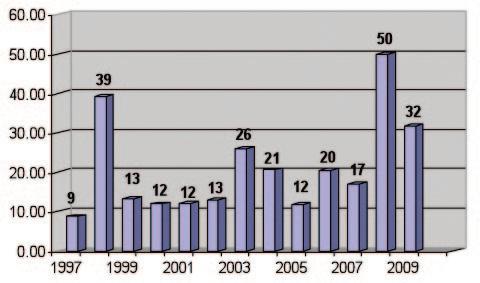
C ustom Fit training funds are used to help companies train employees and is administered through state colleges and state applied technology centers.
Private Activity Bond
The Private Activity Bond is Utah’s tax-exempt bonding authority creating a lower cost, long-term source of capital and is administered by the Department of Community and Culture.
Additional incentive programs specific to rural counties can be found in the Rural Development Section.
20 Governor’s Office of Economic Development • Annual Report 2010 • www.business.utah.gov
Years
Millions of Dollars

21 Governor’s Office of Economic Development • Annual Report 2010 • www.business.utah.gov Corporate Recruitment and Incentives
IAF/EDTIF Performance U tah Code Ann. § 63M-1-901, 909, 2406 and 2407 Renewable Energy Development Act U tah Code Ann. § 63M-1-2801
Corporate Recruitment and Incentives
Overall Performance for Corporate Recruitment and Incentives
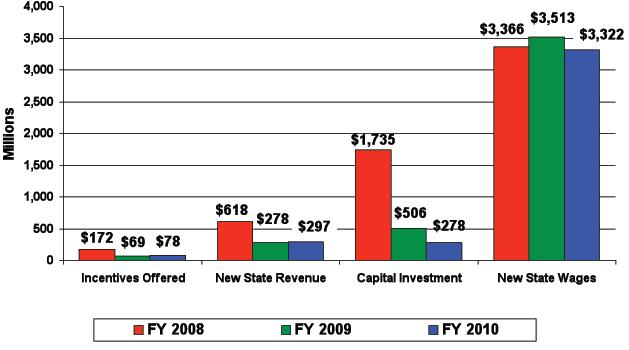
Total EDTIF Commitments (remaining balances of contractually obligated incentive payments):
•Cash grants $108,720,570 representing 5 companies
•Tax credits $112,619,158 representing 26 companies
Actual Partial Rebates for FY 2010:
•6 projects with actual payouts totaling $3,514,087
Actual Tax Credits for Fiscal Year 2010:
• 22 projects with actual tax credits totaling $2,383,152
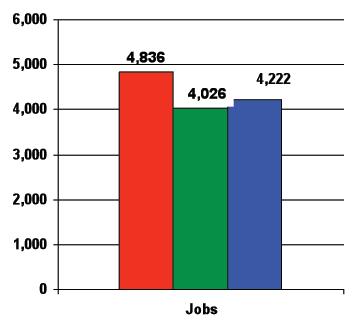
Total IAF Commitments (remaining balances of contractually obligated incentive payments):
• Standard IAF $9,078,400 representing 21 companies
•Rural Fast Track Program commitments $985,500 representing 40 companies
•Economic Opportunity $100,000 representing 1 company

For additional information on these incentive programs, visit www.business.utah.gov or contact Christina Oliver, GOED Incentives Manager, at coliver@utah.gov or 801-538-8792.
22 Governor’s Office of Economic Development • Annual Report 2010 • www.business.utah.gov
OVERVIEW
The Utah Health Exchange is designed with the overarching philosophy that the invisible hand of the marketplace, rather than the heavy hand of government is the most effective means whereby reform may take place. The Utah approach to reform is based on enhancing consumer choice and the ability of the private sector to meet consumer needs. The Exchange is part of Utah’s overall health system reform effort that is aimed at increasing the number of Utahans’ with health insurance.
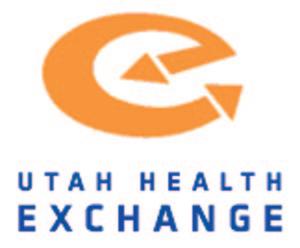
The Exchange formally opened in August 2009 for the individual/family product market as well as a limited launch for the small group market. A full launch of the small group market and a pilot version for the large group market are scheduled for fall 2010.
Insurance for the Individual
Because the individual and family health insurance market in Utah is already quite robust and consumer oriented, the primary role of the Exchange is to connect consumers with private companies that can help them identify and purchase the product they need. On the Exchange, consumers are given three options to shop for and buy a policy—use a private online shopping service, buy direct from a participating insurer, or search for an agent to get in-person assistance. Currently, there are four private online shopping services, five insurers and hundreds of agents available through the Exchange.
Defined Contribution Market
When it comes to employment-based health insurance, Utah recognizes that the traditional approach to purchasing a group plan is not consistent with the underlying philosophies of health system reform. In 2009, Utah created a new defined contribution market for health insurance. In this market, employees choose their own insurance company, network, and benefit structure and employers simply decide how much to

23 Governor’s Office of Economic Development • Annual Report 2010 • www.business.utah.gov Office of Consumer Health Services

contribute toward the employee’s policy. It is apparent that while this market greatly enhances consumer choice and competition among insurers, it is also a more complicated system with many more people needing information than in the traditional group market.
The Exchange serves as the technology backbone that makes such an innovative market possible. The Exchange has the capacity handle employer enrollment, communicating information to insurers about risk, compiling and displaying price information to employees, executing the employees’ enrollment in their choice of plan, and facilitating the collection and distribution of premiums.
24 Governor’s Office of Economic Development • Annual Report 2010 • www.business.utah.gov Office of Consumer Health Services
Courtesy of Utah Insurance Department
One important note is that this new consumer flexibility also creates a new kind of risk for insurers because sick and healthy employees may not evenly spread themselves across insurers and in employer-based markets insurers cannot price accordingly. In Utah, the key to making this market feasible is the development of a risk adjuster that helps insurers address the uncertainty that is due to consumer choice. The risk adjuster was developed and implemented cooperatively by participating insurers through the Utah Defined Contribution Risk Adjuster Board.
Small Businesses
The Exchange conducted a test run of the technology system for small businesses (2-50 employees) in the fall of 2009. The test run gave employees their choice of over 60 plans from three different carriers with a wide range of benefit plans. At the end of the test run, 13 employers used the Exchange to provide a health benefit for their employees, resulting in over 400 people enrolled in health insurance plans that they chose for themselves. Currently, there are well over 600 small employers on a waiting list who want to use the defined contribution market of the Exchange as their employee benefit plan when it reopens this coming fall. There are now four insurers committed to offering policies.
The Exchange is working with brokers and agents that specialize in small group policies to help them educate employers about the potential benefits of using a defined contribution approach to health benefits and facilitate the use of the Exchange as their enrollment mechanism.
Large Group Market
For large employers Utah statute requires that the defined contribution approach be available through the Exchange by January 1, 2012. In order to meet that objective, the Exchange is in the middle of conducting a pilot project with eight large employers focused on developing the technology to make that a reality. As part of this pilot project, the Exchange will open for a special enrollment of employees of pilot project partners in the fall of 2010. If all employees and dependents of the pilot project partners participate, enrollment through the Exchange could easily exceed 40,000 covered lives in 2011.
Work in Progress & Federal Health Reform
The Exchange also has as one of its primary objectives to be a source of information for consumers on cost and quality of providers and health insurers. The Exchange is working with the Utah Department of Health’s All Payer Database to develop interfaces that will allow consumers access to data to help them make better choices about insurance and providers.
25 Governor’s Office of Economic Development • Annual Report 2010 • www.business.utah.gov Office of Consumer Health Services
Office of Consumer Health Services
Adv isory Boards comprised of health care providers, payers and consumers have been established that provide the Exchange with feedback used to refine operations, messaging and management. Further work is underway to increase the functionality of the Producer Search tool that allows consumers to find licensed and appointed producers who are authorized to sell in the Exchange
In the light of federal health care reform, the Exchange provides one of two examples of functioning exchanges that could serve as models for other states that will need to develop one. While Utah is still working to understand the details of how the Exchange will need to adjust to meet the requirements of the federal reform, it is very likely that the core features of the defined contribution market and the technology to facilitate consumer choice will be a part of Utah’s plan for the foreseeable future.
“ The Right Approach to Health Care Reform”
In a Backgrounder article published on April 9, 2010, The Heritage Foundation called Utah’s consumer-focused health reform, including the Exchange, the “r ight approach” to attacking the problems in the health system. Our experience shows that state lawmakers can build reforms unique to their local markets and populations that will be more consumer-oriented and business friendly. Because Utah is not Massachusetts and Massachusetts is not Utah, each state needs the flexibility to design a system that works for them. Utah has made great strides in designing such a system and their approach to health care reform could be a model for many other states that are faced with similar issues.

For additional information about the Office of Consumer Health Services visit www.business.utah.gov or contact Matt Spencer, Program Manager, at mspencer@utah.gov or 801-696-4506.
26 Governor’s Office of Economic Development • Annual Report 2010 • www.business.utah.gov
OVERVIEW
The Mission of the International Trade & Diplomacy Office (ITDO) is to “Increase exports, foreign direct investment, and international trade jobs in Utah.”
Business Mentoring and Training
The ITDO Regional Directors assist Utah companies to do business internationally and expand existing markets. This assistance is provided in one-on-one mentoring, region-specific training seminars and trade missions. Additionally, ITDO holds numerous networking events. In FY 2010, ITDO assisted 495 companies and trained 1280 companies through 47 training events. A schedule of upcoming events can be found at http://goed.utah.gov/international-trade/International/.
Diplomacy
ITDO represents the state of Utah and the Governor on all diplomatic and trade matters, including hosting foreign dignitaries and delegations. Because of the strong relationships between Utah and numerous foreign countries, ITDO is able to connect Utah companies to diplomats and business leaders around the world.
Export Growth
Figures at a Glance
Overall Export Growth (’05-’09):
Utah GDP Growth (’05-’08):
Export Growth by Key Country (’05-’09)
• China:
• India:
•
ITDO works closely with a number of internationally focused partners, including the U.S. Commercial Service, and Wo rld Trade Center Utah, Wo rld Trade Association of Utah. Utah has experienced strong economic growth related to international trade. From 2005 to 2009 Utah’s exports grew by 70.37 percent (compared to the national average of 17.3 percent). In fact, Utah ranked first for export growth in the United States from 2008 to 2009. These exports help fuel Utah’s job creation, especially for small and medium-sized businesses. A total of 2,887 companies exported goods from Utah locations in 2008, an increase of 29 percent since 2006.
Diplomatic
Educational
Seminar
27 Governor’s Office of Economic Development • Annual Report 2010 • www.business.utah.gov International Trade and Diplomacy
. . . . . . .70.36%
. . . . . . . . . . .12.7%
. . . .
. . . . . . .122.99%
. . . .
. . . . . . .
. . . . . . . . . . . .1,098.83%
Canada: . . . . . . . . . . . . . . . . . . . . .42.87%
. . . . . . . . .
•
Mexico: . . . . . . . . . . . . . . . . . . . . .116.12%
Supported by International Trade (2006): . . . . . . . . . . . . . . . . . . .259,724 Trade Delegation Visits: . . . . . . . . . . . . . . . . .40
Jobs
Visits: . . . . . . . . . . . . . . . . . . . . . . .48
Assisted: . . . . . . . . . . . . . . . . . .495
Companies
Seminars: . . . . . . . . . . . . . . . . . .47
Attendees: . . . . . . . . . . . . . . . . . .1,280
Missions: . . . . . . . . . . . . . . . . . . . . . . . . .0
Trade
International Trade and Diplomacy
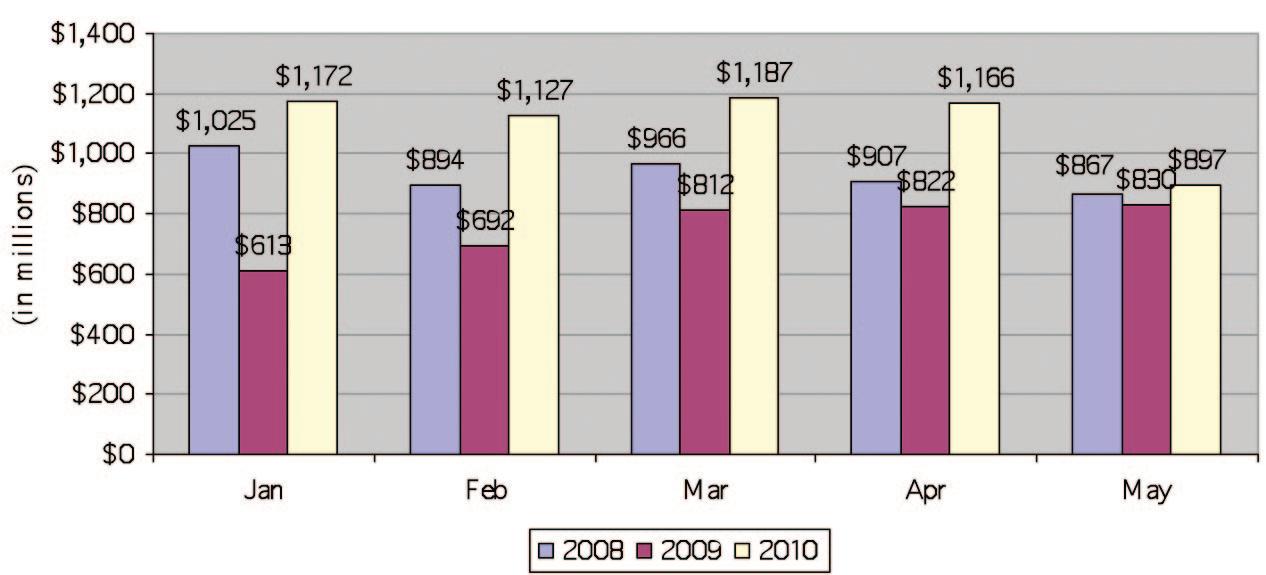
Figures are in millions
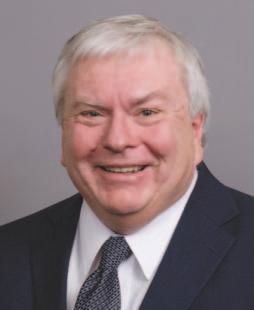
For additional information about International Trade and Diplomacy visit www.business.utah.gov or contact Craig Peterson, Director, at cepeterson@utah.gov or 801-538-8778.
28 Governor’s Office of Economic Development • Annual Report 2010 • www.business.utah.gov
Utah70.36% Washington56.42% Montana44.07% Nevada43.92% Oregon20.22% Idaho18.52% U.S.17.30% California2.96% Arizona -6.18% Colorado -14.66% New Mexico -50.08%
Utah Commodity Exports
2005-2009 %
1 Precious Metals$5,146 2Electronics$1,350 3 Medical Equipment$496 4 Industrial Machinery$417 5 Aerospace Equipment$284 6 Edible Preparation$283 7 Auto Parts$231 8Ores$219 9 Copper$205 10Cosmetics$191
Utah Commodity Exports – 2009
OVERVIEW
The Pete Suazo Utah Athletic Commission (PSUAC) was established under the Utah Professional Athletic Commission Act became law in July 2001. The fiver-member Commission, appointed by the Governor and Legislature, regulates professional boxing and other amateur and professional unarmed combat sports including boxing, kickboxing and mixed martial arts (MMA). Promoters, managers, contestants, seconds, referees and judges are licensed under the Act and subsequent statute revisions and rules. Fees are intended to cover cost of protecting the health and welfare of contestants and regulating events within the State.
The commission is named after the late Utah State Senator Eliud “Pete” Suazo. Pete Suazo was an advocate for youth and minorities in the state and a boxing enthusiast. More information about Senator Suazo’s life can be found in the article “La Voz de los Otros”: An Overview of the Life and Career of Eliud “Pete” Suazo, Utah’s First Hispanic State Senator, 1951-2001, wr itten by Jorge Iber and published in the Spring 2008 Utah Historical Quarterly.
The PSUAC regulates and oversees nearly 70 unarmed combat events per year. Attendance at these events varies from about 100 spectators to over 5,000 spectators attending large events. This last year, we were disappointed to see the Ultimate Fighting Championship (UFC) cancel its proposed MMA show in Salt Lake City, but we continue to encourage the UFC and other major out of state to schedule future unarmed combat events in Utah. Two Utah MMA athletes were successful in signing contracts with the UFC after successful appearances in the Ultimate Fighter championships.

During the past year, Mark Burnett Productions filmed its third season of the popular “Bully Beat Down” reality television show that is broadcast on the MTV cable network and provided support to local film production businesses in Utah.
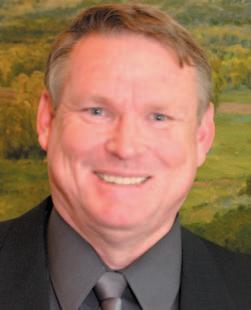
For additional information about the Pete Suazo Utah Athletic Commission visit www.business.utah.gov or contact Bill Colbert, Commission Director, at bcolbert@utah.gov or 801-538-8876.
29 Governor’s Office of Economic Development • Annual Report 2010 • www.business.utah.gov
Pete Suazo Utah Athletic Commission
Utah #1
“Expected
Economic Recovery”
– American Legislative Exchange Council – ALEC – March 2010
Laffer and his co-authors, Stephen Moore, senior economics writer at The Wall Street Journal, and Jonathan Williams, director of the Tax and Fiscal Policy Task Force for ALEC, analyze how economic competitiveness drives income, population and job growth in the states. They found that, “states with a high and rising tax burden are more likely to suffer through economic decline, while those with lower and falling tax burdens are more likely to enjoy robust economic growth.” According to Williams, “The top performing states keep taxes, spending, and regulatory burdens low, while the biggest losers in the book tend to share similar policies of high tax rates, unsustainable spending and regulation.”

Utah #1
“
The Best Managed State in the Nation”
– The Pew Center on the States 2008
Re ported in Governing Magazine: Measuring Performance – March 2008
The Center ranked the states based on how well they manage their budgets, staffs, infrastructure and information. States were graded on their recruitment and retention of qualified employees, their use of information and technology, management of budgets and purchasing systems, and planning for improvements to roads, bridges and other core infrastructure.
30 Governor’s Office of Economic Development • Annual Report 2010 • www.business.utah.gov
OVERVIEW
Helping Utah companies secure military and government contracts.
PTAC provides assistance to small and mid-sized Utah companies in obtaining government contracts-be they federal, state, or local. Results for FY 2010 indicate that PTAC helped Utah small businesses obtain more than $500M (that’s 1/2 Billion Dollars) in contracts creating / retaining10, 000 jobs-at $50,000/job. The return on investment is significant, since the average cost of each new or retained job is less than $500 per job. PTAC’s budget of $740K is provided by matching funds from the Department of Defense and the State of Utah. There is no more efficient use of funding, as applied to job creation, than the work of PTAC’s efforts for the Governor’s Office of Economic Development (GOED.)
PTAC Counselors provide one-on-one and group instruction that helps clients identify contracting opportunities, which can create growth of market share and revenues, for them. The government is an excellent customer because it generally purchases in large quantities and pays its bills on time.
PTAC is an important part of GOED with eight offices throughout the state, from Logan to St. George.
There are specific keys available from your PTAC Office as follows:
• Bid match software to find bid opportunities
• One-on-one Counseling
• Workshops and Conferences
• Registration Assistance (Duns, CCR, ORCA)
• Networking facilitation Through “Outreach Events”
• Contracting Partnerships
- Prime / Sub
- Mentor / Protégé
- Teaming Agreements
- 8(a) / Hub Zone Opportunities
• Bid Proposals (response to an RFP)
• Product Specifications / Standards
• Procurement Histories / Pricing Data
• GSA Assistance
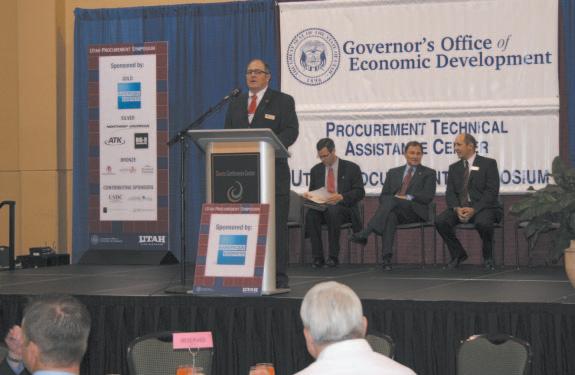
31 Governor’s Office of Economic Development • Annual Report 2010 • www.business.utah.gov
Centers (PTAC)
Procurement Technical Assistance
Governor Gary R. Herbert’s Introduction as Keynote Speaker for PTAC Symposium.
Camp Williams Data Center Outreach Events:
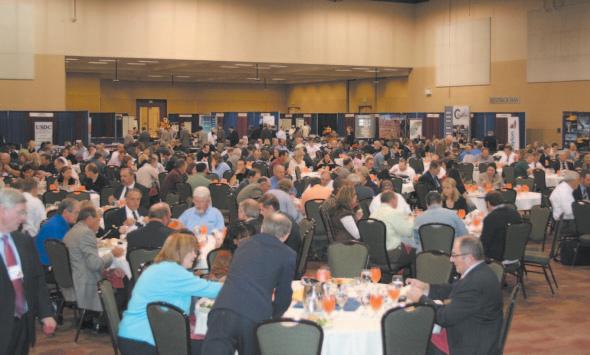
PTAC held multiple Outreach Events for various Teams of Prime Contractors bidding on this $1.6 Billion project. Final submittals from five teams were received by the Federal Government in mid June, and the Design / Build project will be awarded this fall. Expectations are that many Small and Disadvantaged Business will participate as sub-contractors in this multi-year project. As soon as the Prime Contractor Team is announced, additional Outreach Events are planned by PTAC to facilitate our clients with the networking opportunities to become a sub-contractor in this huge building project.
According to PTAC State Director, Fred Lange, outreach events are structured to bring many Prime Contractors together with Utah’s small businesses, in a similar way as the Data Center events have been scheduled. Another example of a recent Outreach Event was one held for Okland Construction who was awarded the Federal Courthouse Project in downtown Salt Lake City. This project is close to $500 Million, and has already begun.
Chuck Spence, Deputy Director of the Statewide PTAC Program, helped to facilitate a SDVOB client company in Park City with two National Companies in a Teaming arrangement. Together the “team” will work as a sub-contractor for various Prime Contractors for many Utah building projects - now and in the future.
The fourth annual Procurement Symposium held in October of 2009 at the Davis Conference Center in Layton, saw more than 500 attendees learn how to sell to the Government and Military, and also were privileged to hear a motivating and encouraging keynote speech from Governor Herbert.
This year, on October 21, PTAC has scheduled its fifth annual Procurement Symposium. This fall, the Symposium will be held at the SouthTowne Expo Center in Sandy, and will again include a Keynote address by Governor, Gary Herbert. As in years past, more than fifty large prime contractors and government agencies will have booths—to facilitate networking opportunities for our many state-wide PTAC clients. There will be a number of “break-out” training sessions for Utah’s small business community, using topics of interest to all attendees.
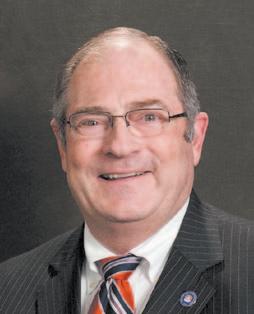
For additional information about PTAC visit www.business.utah.gov or contact Fred Lange, Director, at fglange@utah.gov or 801-538-8773.
32 Governor’s Office of Economic Development • Annual Report 2010 • www.business.utah.gov
Procurement Technical Assistance Centers (PTAC)
PTAC Symposium General Session
OVERVIEW
The Rural Development Program Mission is to “Unite and support Utah’s rural communities in economic development through coalitions, entrepreneurship, business expansion and infrastructure development.”
Rural Partners
The Governor’s Rural Partnership Board, with representation from business, industry, and local government raises awareness about rural development needs, defines economic barriers and raises these issues with the Governor, Utah Legislature and other state and federal agencies.
GOED as partnered w ith USU Extension on seminars, workshops and coordinated programs. Topics have included manufacturing, Utah’s Own Program, federal stimulus funds, co ngressional delegation updates and renewable energy.

Feed Mill in Lynndyl, Utah.
GOED’s Rural Development team supports local economic development professionals, rural communities, and organizations such as the Center for Rural Life. Recently, GOED has partnered with the Utah Petroleum Association and the State Energy Office on energy issues.
In addition to the programs listed below, Rural Development facilities assistance through numerous other programs such as local revolving loan funds, Small Business Development Centers, SBA business programs, Utah Science Technology and Research, certified development companies, custom fit training and the Manufacturing Extension Partnership.
Business and Economic Development Assistance
• Rural Development Grants
Matching funds of up to $10,000 are available to communities to facilitate economic development projects. Grants are awarded as they are received, based on the quality of the project and available funding. The following two projects were
33 Governor’s Office of Economic Development • Annual Report 2010 • www.business.utah.gov
Rural Development
Rural Development
funded during FY 2010: Casino Star Theatre in Gunnison and Business Resource Center Outreach in Beaver and Garfield.
• Enterprise Zones, (63M-1-401)
Businesses within an Enterprise Zone can claim state income tax credits for investing in plant and depreciable machinery and equipment, creating new above average wage jobs, and the rehabilitation of older facilities. In 2008 over $8.3 million in tax credits were given, estimated to equal over $70M of business investment in rural Utah.
• Targeted Business Tax Credits, (63M-1-2001)
Companies can receive refundable state tax credits for non-retail businesses in qualifying enterprise zones. Each year the state awards a maximum of $300,000 to companies based on projected investment and payroll. If projections are reached, the companies awarded the targeted business tax credits will receive tax credits in each of the next three years. In FY 2010, GOED did not receive any application for new business projects, but has awarded state income tax credits to the following projects approved in FY 2009: Filter Service Company, Electrical Contractors, San Rafael Veterinary Clinic, Neilson Cement, Palletta Trucking and Badlands Fabrication.
• Rural Fast Track (RFT), U.C.A. 63M-1-904
A portion of the IAF is designated for non-retail companies in rural Utah (counties with a population less than 30,000 and average household income less than $60,000) for business expansion and the creation of new high paying jobs.
Rural Fast Track Program Offers
34 Governor’s Office of Economic Development • Annual Report 2010 • www.business.utah.gov
County# of JobsIncentiveInvestment Carbon4$ 96,507$ 212,364 Duchesne1$ 50,000$ 110,000 Emery1$ 31,000$ 61,350 Juab2$ 90,000$ 229,900 Millard2$ 87,000$ 174,000 San Juan3$ 93,000$ 202,719 Uintah1$ 50,000$ 435,010 Wayne3$ 125,933$ 289,200 Grand Total17$ 623,440$ 1,714,543
FY 2010
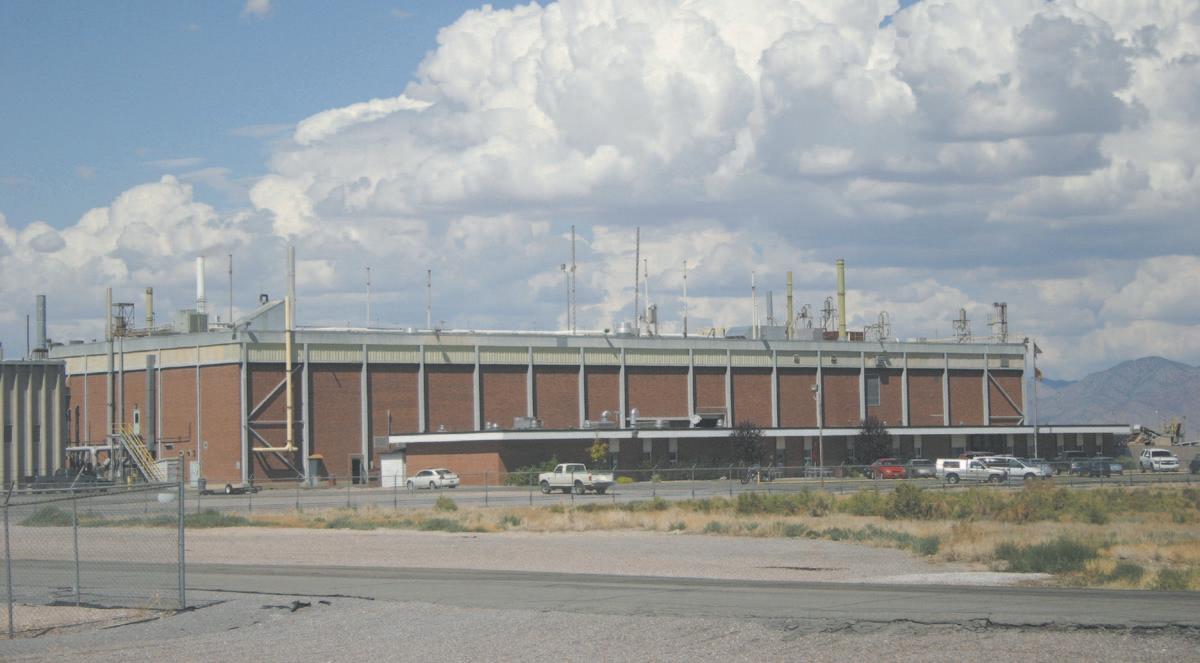

35 Governor’s Office of Economic Development • Annual Report 2010 • www.business.utah.gov Rural Development Rural Fast Track Program Disbursements FY 2010 County# of JobsIncentiveInvestment Beaver0$ 50,000$ 127,275 Carbon21$ 270,680$ 2,904,086 Duchesne0$ 127,650$ 275,920 Emery0$ 173,000$ 428,539 Grand0$ 30,316$ 88,400 Juab0$ 149,891$ 428,975 Millard0$ 37,000$ 74,771 Sanpete0$ 138,681$ 322,058 Grand Total21$ 977,218$ 4,650,023
Brush Resources, Delta, Utah.
Horizon Metals, Nephi, Utah.
Rural Development
• Rural Broadband, Service Fund 63M-1-2301
Established to support economic growth in rural locations by providing post performance cash grants to companies that commit to construct wire line technology for broadband service in rural communities. To date, 47 projects in 14 Counties have extended high speed internet to approximately 10,615 potential subscribers.
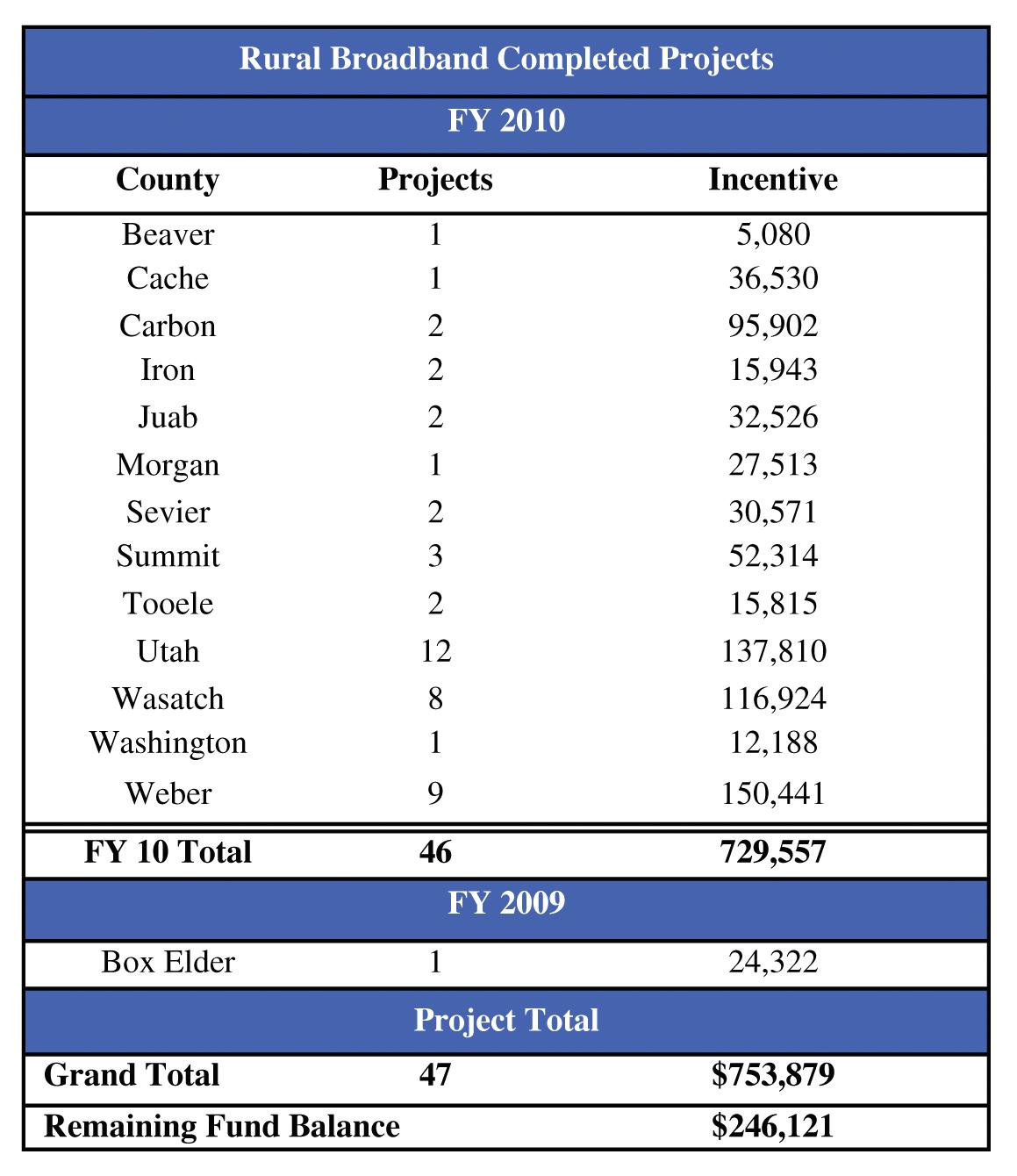
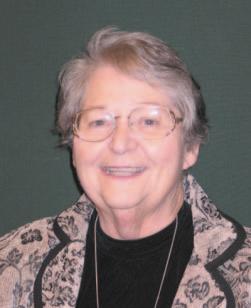
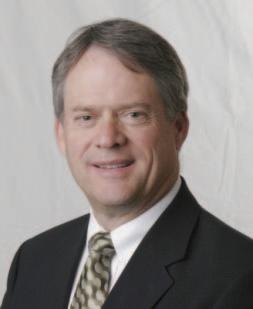
For additional information about Rural Development visit www.business.utah.gov or contact Beverly Evans, Director, at bevans@utah.gov or 801-538-8638, or contact Les Prall at lprall@utah.gov or 801-538-8804.
36 Governor’s Office of Economic Development • Annual Report 2010 • www.business.utah.gov
Overview
The State Science Advisor (SSA), appointed by the Governor, provides advice and counsel on science and technology issues to the Governor, state legislature and other state agencies. The Science Advisor serves on a broad range of boards and commissions pursuant to the oversight of key scientific initiatives, research efforts, federal and state mandates and on-going programs devoted to science and technology issues. The Science Advisor has specific responsibility to supervise or participate in the following key areas:
Adv isory Council on Science and Technology (SAC)
The SSA and SAC review significant advances in science and technology and advise and make recommendations to the Governor, state legislature and governmental agencies on the use of science and technology to foster scientific literacy and to strengthen the state’s economy, educational system and quality of life. The SSA serves as an ex-officio member of the SAC and provides staff support for all SAC activities and initiatives. This y ear the SAC solicited and revi ewed 50 nominations for the Governor’s Medal for Science and Technology. The dinner was held at the Discovery Gateway with nearly 200 attendees. Chris Eisenberg, a former National Public Radio journalist, was the emcee for the event. Dr. Sarah George the Director of the Utah Museum of Natural History was the keynote speaker, with Governor Herbert presenting the awards to the seven awardees. The Governor’s Medal is a symbol of recognition for those individuals who have provided distinguished service in the fields of science and technology. The Governor’s Medal recognizes outstanding achievement in the following areas: academia, industry, government and education. The SAC also appointed one new member this year: Dr. Jennifer Logan. The SAC is also serving as the Executive Committee for the WIRED initiative that is helping to create a talent “pipeline” for the Utah life science community.
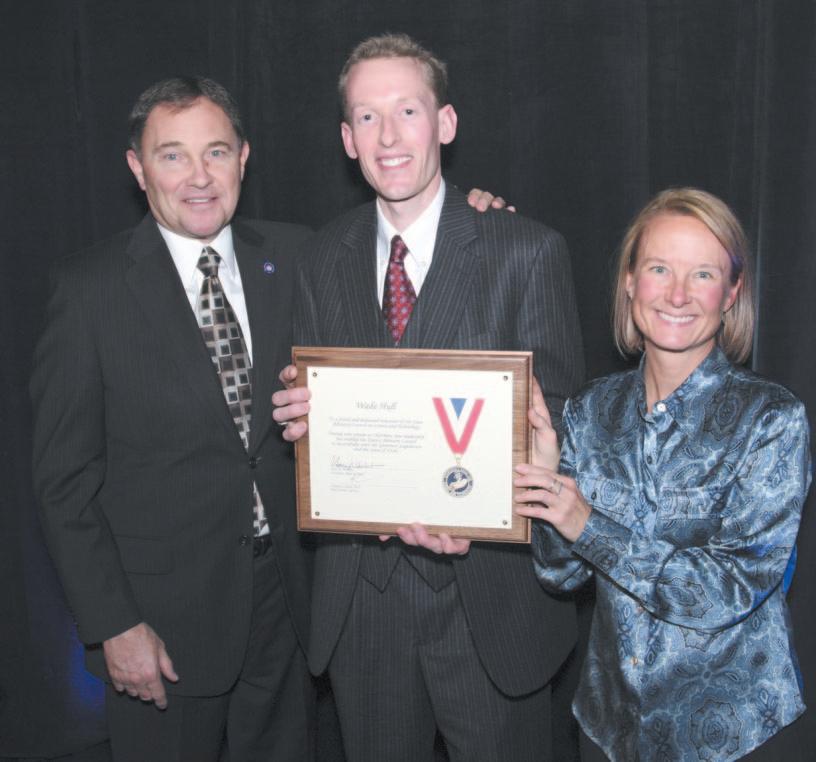
37 Governor’s Office of Economic Development • Annual Report 2010 • www.business.utah.gov
Science
State
Advisor
Governor Gary R. Herbert, Wade Hull, SAC Outgoing Chair, Tami Goetz, State Science Advisor.
State Science Advisor
Workforce Innovations in Regional Economic Development (WIRED)
•The Governor’s Office of Economic Development (GOED) received a US Department of Labor grant for $5.16 million through the Workforce Innovations in Regional Economic Development (WIRED) program. This 3-year grant focuses on supporting the Utah life science industry by building strong partnerships through government agencies, higher and public education institutions, life science industries and community and philanthropic entities.
•There are nine partners, including higher and public education, government, community/philanthropic and industry whom will work together to create outreach and recruitment activities, as well as education and training programs that support the life science industry in Utah.
•The Utah Valley University 4-year Biotechnology Program continues to grow, w ith 177 students currently enrolled in its second year.
•The life science training business incubator, BioInnovations Gateway (a collaboration between USTAR and the Granite School District) has company presence and is working to establish unique partnerships that support student entrepreneurship training.
•The Utah State University Science Education Training program plays a vital role in rural Utah by offering science and math workshops to give students and the community exciting options for summer opportunities.
•The Face of Fitness program in the Salt Lake City School offers a summer program that allows students to learn concepts in physics, math and engineering while discovering local outdoor product companies.
•Progress is being made in producing a strategic plan that will help to support Utah’s rapidly growing and changing natural products and dietary supplement industry. This strategic plan will be included as part of the BioVision effort being coordinated by the Utah Technology Council.

For additional information about the State Science Advisor visit www.business.utah.gov or contact Dr. Tami Goetz at tgoetz@utah.gov or 801-538-8871.
38 Governor’s Office of Economic Development • Annual Report 2010 • www.business.utah.gov
Utah Broadband Mapping, Analysis and Planning Project
OVERVIEW
The U tah Broadband Mapping, Analysis and Planning Project (UBMAPP) is joint effort between the Governor’s Office of Economic Development (GOED), the Public Service Commission (PSC), and the Utah Automated Geographic Reference Center (AGRC), to develop a statewide map of available broadband services and a plan to increase broadband adoption and deployment in the state. The project will help identify critical unserved or underserved areas and populations. This information will help in the development of a plan to expand affordable, reliable broadband services to every citizen of the state.
Like electricity a century ago, high-speed Internet access, or “broadband” is now a driver for economic growth, job creation, global competitiveness and a better way of life. It provides the capability for people to interact in new ways resulting in the creation of new industries and is unlocking vast new opportunities for existing ones. It is changing how we educate children, deliver health care, manage energy, ensure public safety, engage government, and access, organize and disseminate knowledge.
The UBMAPP team has formed public-private partnerships with 60+ broadband providers across the state (listed on the following page). With the engagement of these providers, the project will establish a quantifiable long-term vision for expanding reliable high-speed Internet access statewide. UBMAPP is working closely with providers as well as anchor institutions and public-interest organizations such as higher education, K-12, health care, public safety, libraries, civic organizations, and tribal entities to identify currently unserved or underserved areas and populations. GOED is convening a roundtable event with broadband stakeholders in Fall 2010 to kickoff the Broadband Plan’s development which will address such issues as competition policies, efficient resource allocation, and infrastructure within the broadband industry.

Ensuring broadband access to both rural and urban Utah communities is a pr iority for UBMAPP. Here fiber is being laid along the I-80 corridor.
39 Governor’s Office of Economic Development • Annual Report 2010 • www.business.utah.gov
Utah Broadband Mapping, Analysis and Planning Project
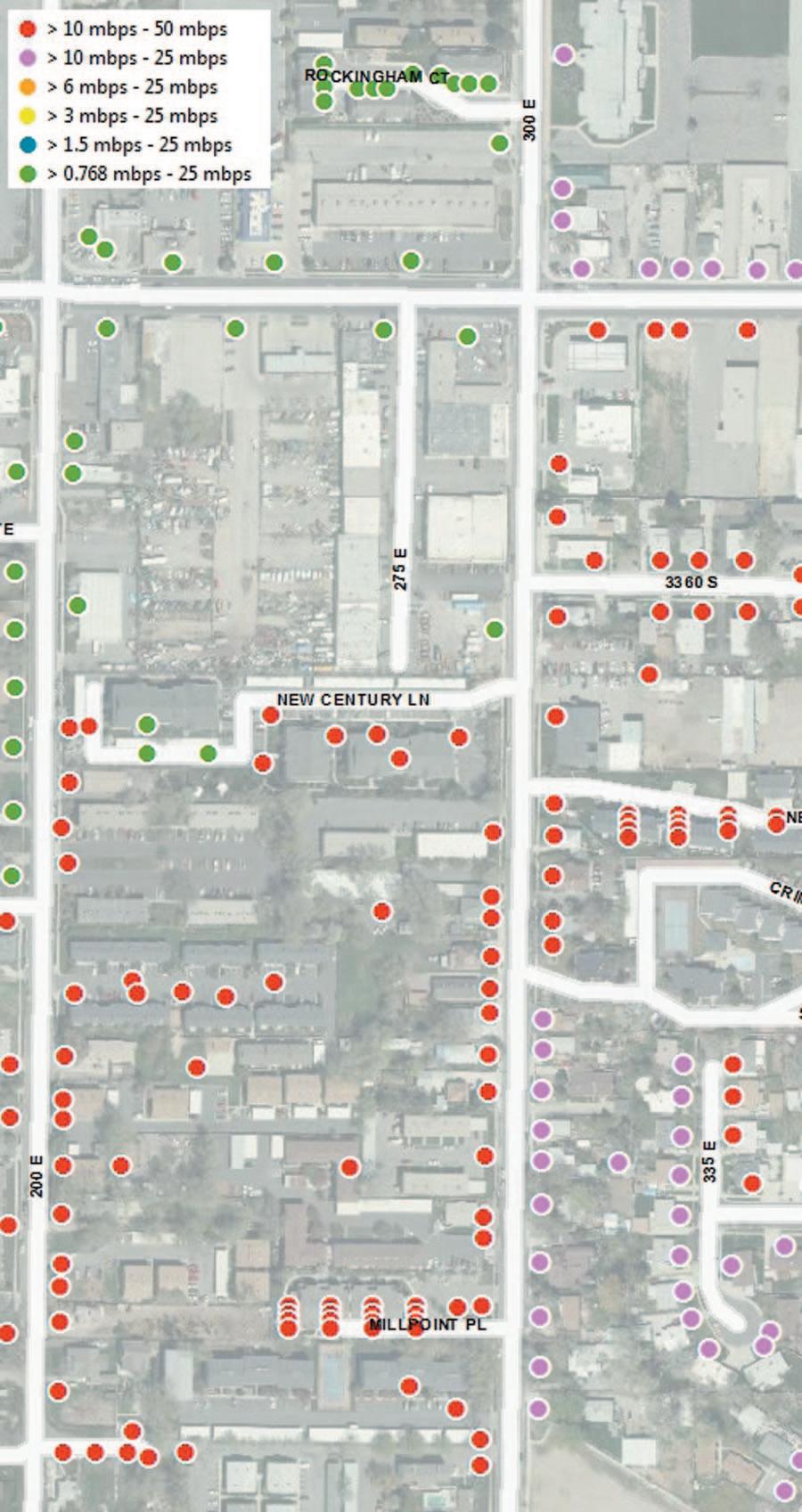
Maximum advertised broadband download speeds available from wireline providers, shown using a sample from AGRC’s address point data. Similarly mapped broadband data is being compiled for all areas of Utah.

BROADBAND PROVIDERS PARTNERING WITH UBMAPP
As of August 18, 2010, the following Utah broadband providers have engaged in participation with the Project:
• 360 Networks
• All West Communications
• American Fiber Systems
• AT&T
• Baja Broadband
• Beehive Telephone
• Bresnan Communications
• BrighamNet
• CentraCom Interactive
• Central TelCom Services
• City of American Fork
• Clearwire Corporation
• Comcast Cable Communications
• Connected Lyfe
• Covad Communications
• Digis
• Direct Communications Cedar Valley
• Emery Telcom
• Farmers Telephone Company
• Fibernet
• Frontier Communications
• Gunnison Telephone
• HNS License Sub
• Ikano
• InfoWest
• Integra Telecom
• Interlinx Communications
• Leap Wireless
• Level 3 Communications
• Manti Tele Communications
• New Edge Network
• Orbitcom
• PAETEC
• PDQ Xchange
• Qwest Communications
• Rapidwave
• Satview Broadband
• Smith Bagley
• South Central Communications
• Sprint Nextel
• StarBand Communications
• Strata Networks
• Union Telephone
• Utopia
• Veracity Networks
• Verizon
• Voonami
• WildBlue Communications
• XMission
• XO Communications
• Xpressweb Internet Services
For additional information about UBMAPP visit www.business.utah.gov/broadband or contact Tara Thue, Broadband Mapping and Planning Coordinator, at tthue@utah.gov or 801-538-8742.
40 Governor’s Office of Economic Development • Annual Report 2010 • www.business.utah.gov
Utah Film Commission
OVERVIEW
The Utah Film Commission markets the entire state as a location for film, television and commercial production by promoting the use of local professionals, support services and Utah locations. The film commission is a client driven program, which serves international, out-of-state and in-state production companies along with Utah support services and crew.
Utah Code Ann. § 63M-1-1805
MOTION PICTURE INCENTIVE FUND
The purpose of the Motion Picture Incentive Fund (MPIF) is to encourage the use of Utah as a destination for the production of motion pictures, television series, and made-for-television movies. The State of Utah provides financial incentives to the film industry so that the state is capable of competing successfully with other states and countries that offer film production incentives. The MPIF allows the state to foster a strong local motion picture industry that will contribute substantially to improving the state’s economy.
The MPIF functions as a tax credit or cash rebate for approved productions and operates on a post performance basis on expenditures that are made in the state.
State Approved Rebate Percentages
FISCAL YEAR TOTALS
Features/Independents/ Cable Features
Total Projects: 20
Total Production Days: 424
Economic Impact: $48,972,634
Television
Total Projects: 23
Total Production Days: 130
Economic Impact: $3,042,680
Commercials / Videos / Industrial / Documentary / Shorts / Stills
Total Projects: 68
Total Production Days: 45
Economic Impact: $1,122,118
Other Related Film Activities
Sundance Film Festival: $62,700,000
Overview
Total Projects: 111
Total Production Days: 599
Total Economic Impact: $115,837,432
• Tax Credit – 20% on dollars left in the state with no per project cap
• Cash Rebate – 20% on dollars left in the state up to $500,000 per project
• Cash Rebate – 15% on dollars left in the state up to $30,000 per project
Dollars Left in the State Requirements
• Minimum $1 million spend for the 20% incentive
• Minimum $200,000 spend for the 15% incentive
Funds Allocated for Tax Credit
• Fiscal Years 2010 – 2011: $15,587,400
41 Governor’s Office of Economic Development • Annual Report 2010 • www.business.utah.gov
Utah Film Commission
Funds Allocated for Cash Rebate
• Fiscal Year 2010: $2,206,300
• Fiscal Year 2011: $2,206,300
Fiscal Year 2010 MPIF Report
For FY 2010 the MPIF operated with both a 20% tax credit or cash rebate and a 15% cash rebate.
Dragonfire2068$173,036.00$865,183.00
Five Browns, The525$30,000.00$207,118.00
GGG*2063$190,432.00$952,160.00
John Carter of Mars*45405$5,546,651.00$27,733,255.00
Kane Files2275$30,000.00$233,544.00 Letter, The1842$30,000.00$233,544.00
Peloton*1876$30,000.00$200,000.00
Remember
Rootbeer Christmas, A*1542$30,000.00$320,000.00
Scents and Sensibility*1638$30,000.00$255,046.00
Thrillbillies*12010$250,715.00$1,253,575.00
Unicorn City1850$30,000.00$457,647.00
*Projected
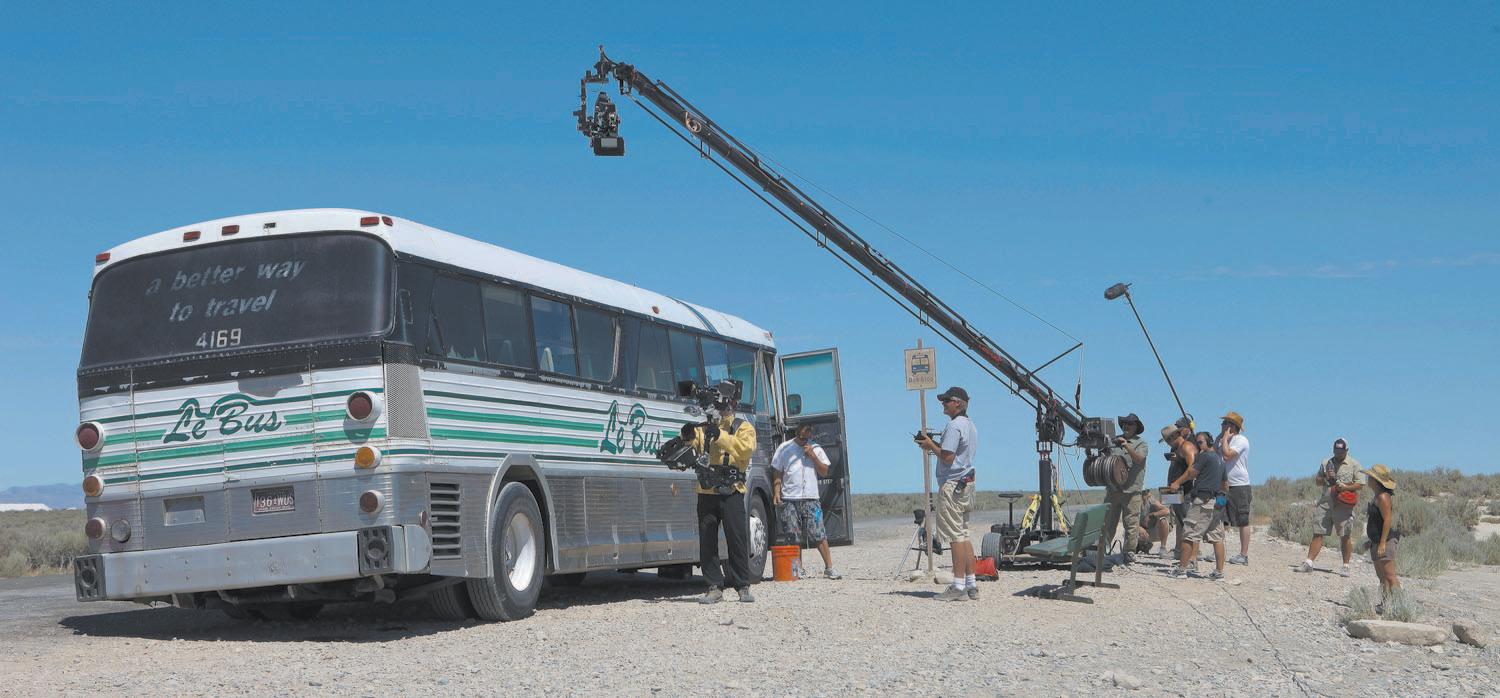
42 Governor’s Office of Economic Development • Annual Report 2010 • www.business.utah.gov
On location GUNS, GIRLS AND GAMBLING in Tooele County.
ProductionDaysUtah JobsIncentive AmountEconomic Impact 127 Hours*40151$2,430,555.00$12,152,778.00 17 Miracles*2190$30,000.00$454,163.00
Photo by Natalie Cass
Den Brother*25117$672,378.00$3,361,890.00
One Tree Hill450$127,000.00$873,180.00
I’ll Always Love You4812$193,850.00$969,248.00
YEARLY TOTAL4551,314$9,825,117.00$50,516,567.00
VARIETY MAGAZINE & COMMON GOOD AWARD
The Utah Film Commission staff was named by Variety Magazine for Best FilmOffice Support by industry insiders in the article “Pros pick best places for filmmaking” and was awarded the Common Good Award by Envision Utah for enhancing Utah’s image throughout the world.
FOX SEARCHLIGHT
The Fox Searchlight film 127 HOURS is based on the real life drama of hiker Aron Ralston who severed his arm to save his life near Moab, Utah in 2003. 127 HOURS is directed by Academy Award winning director Danny Boyle (Slumdog Millionaire) and will star James Franco (Spiderman).
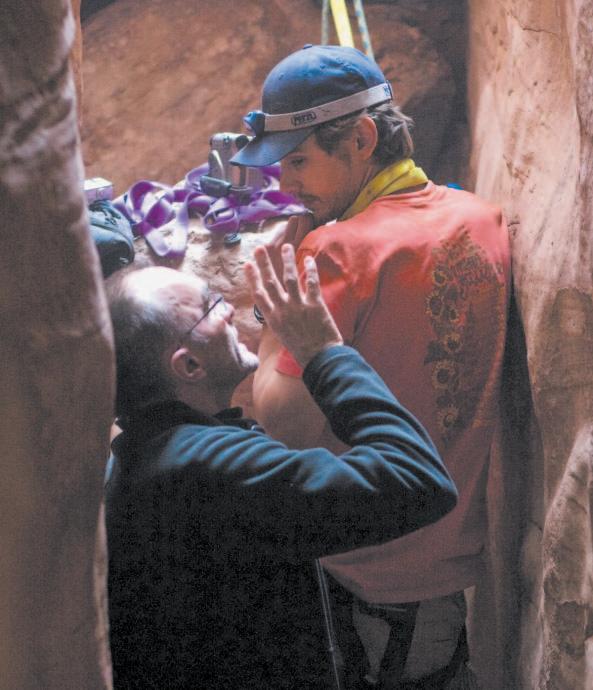
From left: Director Danny Boyle and James Franco on the set of 127 HOURS.
127 HOURS filmed in various parts of Utah, including, Moab, Green River, Sandy, Antelope Island, Tibble Fork Reservoir, Emigration Canyon and Blue John Canyon, where Ralston was actually trapped. The bulk of the studio work was filmed in a converted warehouse in Salt Lake City. The film is scheduled to show at the Toronto Film Festival and close the London Film Festival 2010; Fox Searchlight plans to release the film in theatres November 5th, 2010. The production spent $9 million throughout rural areas of the state over a five month period and created 151 Utah jobs.
DISNEY
In 2009 the Utah Film Commission recruited the big budgeted Walt Disney Studios’ feature film, JOHN CARTER OF MARS, which now stands as the largest film ever to be produced in the state. The film is directed by Academy Awardw inning filmmaker Andrew Stanton (Finding Nemo, Wall-E) and is produced by Colin Wilson (Avatar). Filmed throughout Southern Utah in the areas of Big Water, Delta, Emery, Hanksville, Kanab, and Moab the production created 300 jobs over a 120-day period, and brought $21 million into several rural Utah economies. JOHN CARTER OF MARS is scheduled to be released in the summer of 2012. The movie will star Taylor Kitsch ( X-Men Origins: Wolverine ), Willem Dafoe (Spiderman) and Lyn Collins (Tr ue Blood).
The Disney Channel also returned to the state with the cable feature DEN BROTHER shooting mostly in Salt Lake City and created an economic impact of $3.3 million and created 120 Utah jobs.
43 Governor’s Office of Economic Development • Annual Report 2010 • www.business.utah.gov Utah Film Commission
Photo by Chuck Zlotnick
Utah Film Commission
REMAINING COMPETITIVE
Fo r Fiscal Year
2011 the goal of the Utah Film Commission is to enhance the MPIF by having a competitive incentive rebate and extend the review from a two year to a five year period. This will keep the state more competitive in bringing features and television productions back to the state for a long term commitment. Moreover our goal is to sustain and promote the current b uilt-in incentives such as Utah’s infrastructure, scenery, film crews, equipment, talent pool and close proximity to Los Angeles.
FILM, TELEVISION AND COMMERCIALS SHOT IN UTAH FISCAL YEAR 2010
FILM
• 127 Hours - Moab, Salt Lake City
• After Life - Bonneville Salt Flats
• Age of Dragons - Utah County
• Area 51 - Tooele County, Salt Lake City
• Den Brother - Salt Lake City
• Five Browns, The - St. George
• For Robbing the Dead - Antelope Island, Utah County
• I Live at the House with the Blue Door - Salt Lake City, Wasatch County
• Immortality Bites - Salt Lake County
• John Carter of Mars - Emery, Kane and Grand Counties
• Kane Files - Utah, Tooele Counties and Salt Lake City
• Last Eagle Scout, The - Utah County
• Letter, The - Utah County
• Remember I’ll Always Love You - Salt Lake City, Moab
• Rootbeer Christmas, A - Utah County
• Stand Strong - Salt Lake County
• Unicorn City - Utah County, Salt Lake County
• Wayshower - Carbon County
TELEVISION
• Bridezillas (WETV) - Sandy City
• Bully Beat Down (MTV) - Salt Lake City
• Little Chocolatier’s, The (TLC) - Salt Lake City
• Fabric of the Cosmos (Nova) - Moab
• Man Vs. Food (Travel Channel) - Salt Lake City
• One Tree Hill (CW) - Summit County
• So You Think You Can Dance (FOX) - Salt Lake City
• Thrillbillies (FUEL TV) - Little Sahara Sand Dunes
COMMERICIALS/VIDEOS/INDUSTRIAL/DOCUMENTARY/ SHORTS/STILLS
• 14341 - Music Video
• AT&T- Commercial
• Bing - Commercial
• ESPN Magazine - Still Photo Shoot
• Hat Man - Spy Hop Productions Student Film
• HD Net - Music Video
• Lone - Short
• Microsoft - Industrial
• NA Volkswagen - Multimedia
• National Geographic - Multimedia
• Novell - Commercial
• Nu Skin - Still Photo Shoot
• Proctor and Gamble - Commercial
• Reco - Short
• Unpleasantville - Short
• Verizon Business - Industrial
• Volkswagen - Multimedia

For additional information about the Utah Film Commission visit film.utah.gov or contact Marshall Moore, Director, at mdmoore@utah.gov or 801-538-8740, 800-453-8824.
44 Governor’s Office of Economic Development • Annual Report 2010 • www.business.utah.gov
OVERVIEW
Visits to Utah’s national and state parks, national monuments, as well as skier days were up last year despite a downturn in the economy. However, because room rates were down, transient room tax revenue dropped from nearly $36 million in FY 2009 to $28.5 million in FY 2010. Still, several luxury resorts opened in Utah this year, including Amangiri near Lake Powell, Best Western Bryce Canyon Grand, the Waldorf Astoria Park City, and St. Regis Deer Crest Resort in Park City for a total of more than $528 million spent on construction and over 1,400 full and part-time positions created. The Utah Office of Tourism (UOT) brands and promotes Utah’s great experiences for visitors and citizens in a way that enhances our quality of life. Since the state launched its new “Life Elevated®” brand in April of 2006, visitation to Utah has increased as the awareness has gone up. Last year, 19.4 million visitors were attracted to Utah’s five national parks, more than 43 state parks, 13 world-class ski resorts, recreation areas, historical sites, and other major attractions. Utah lawmakers appropriated $7 million dollars for FY 2010 for out-of-state advertising and cooperative marketing. UOT implemented a winter ad campaign, a non-winter ad campaign, and advertising to promote both Utah and non-stop Delta flights between Paris to Salt Lake City and also Tokyo to Salt Lake City. National cable, television spot markets, online, and print ads were utilized for each campaign. UOT partnered with Ski Utah for winter advertising, which included print and online ads to promote skiing. Ski Utah also conducted a viral campaign in New York City with the “snowflakes” from the winter campaign. In addition, UOT worked with a New York City-based domestic PR firm to help generate articles about the state throughout the nation. Major accomplishments included an extended reach of our message, an improved perception and awareness of what Utah has to offer potential visitors, and monies saved due to lower advertising rates. International tourism plays a key role in Utah’s economy. Some local tourism offices in southern Utah estimate that 70% of their transient room tax collections come from international visitors.

45 Governor’s Office of Economic Development • Annual Report 2010 • www.business.utah.gov Utah Office of Tourism
Tourism Marketing and Performance Fund (TMPF)
FY 2009-2010
Original Appropriation $7 million
• Co-Op Marketing
• Sports Commission
• Total Advertising
– Non-Winter
– Winter
– Special Ops
Advertising Campaigns
Non-Winter 2009
Traveler Spending
Tax Revenue
State
Winter 2009/10
Highlights
million
million
•Traveler spending for 2009 is estimated at $6.2 billion, generating $625 million in state and local tax revenues or $703 per Utah housing unit.
• PR firm Lou Hammond and Associates promoted the state domestically, which attracted more than 20 journalists to the state and generated more than 70 articles. A monthly news release was sent to the media and nearly 120 hot tip leads from various media outlets generated coverage.
•T he Utah Office of Tourism received the Travel and Tourism Research Association’s (TTRA) top national marketing award for the 2009 summer campaign. The J. Desmond Slattery Professional Marketing Award honors the winning program that “demonstrates an innovative and significant contribution to travel and tourism marketing.”
•The Utah Office of Tourism has relaunched its Utah.travel Web site to include more content and links to social media streams in an effort to make it more interactive.
46 Governor’s Office of Economic Development • Annual Report 2010 • www.business.utah.gov Utah Office of Tourism
. . . . . . . . . . . . . . . . . . . . . . . . . . .$1,400,000
. . . . . . . . . . . . . . . . . . . . . . . . . . .
.$700,000
. . . . . . . . . . . . . . . . . . . . . . . . . . . .$4,900,000
. . . . . . . . . . . . . . . . . . . . . . . . . . .
.$2,940,000
. . . . . . . . . . . . . . . . . . . . . . . . . . . . . . .$1,470,000
.
. . . . . . . . . . . . . . . . . . . . . . . . . . . .
.$490,000
. . . . . . . . . . . . . . . . . . . . . . . . .$705
. . . . . . . . . . . . . . . . . . . . . . . . . . . . . .$56
ROI . . . . . . . . . . . . . . . . . . . . . . . . . . . . . . . . . . . . .$13 Local ROI . . . . . . . . . . . . . . . . . . . . . . . . . . . . . . . . . . . . . .$9
. . . . . . . . . . . . . . . . . . . . . . . . .$391 million
Revenue . . . . . . . . . . . . . . . . . . . . . . . . . . . . . .$31 million
ROI . . . . . . . . . . . . . . . . . . . . . . . . . . . . . . . . . . . . . .$6
ROI . . . . . . . . . . . . . . . . . . . . . . . . . . . . . . . . . . . . . .$4
Traveler Spending
Tax
State
Local
•Installation of 35 new “Welcome to Utah” highway signs was completed in May. Funding for the joint project between the Office of Tourism and UDOT was generated from signage collections over a three-year period.

•The 2010 Official Utah “Life Elevated ® ” Scenic Calendar was honored with eight Gold Awards for graphic design, printing, and other categories in the 2010 National and World Calendar Awards competition, hosted by the Calendar Marketing Association.
•Utah received $450,488 in five National Scenic Byway grant awards for projects in rural areas of the state.
Co oper ative Marketing Program
The mission of the Utah Cooperative Marketing Program is to leverage state and partner funding to attract out-of-state visitors and increase tourism expenditures. Using a 50-50 match of public and private marketing monies, tourism partners are able to double out-of-state marketing efforts. Destination marketing organizations and non-profit entities in existence for one year or more are eligible to apply.
FY 2009-2010
The Board of Tourism Development funded 36 of 52 applications for $1.5 million.
Travel Trade Program
The Travel Trade Program’s objectives include growing/enhancing do mestic and international published Utah travel products and branding Utah to worldwide audien c es as an exciting year-round travel destination. Program components include media/trade FAM tours, collateral development, press

47 Governor’s Office of Economic Development • Annual Report 2010 • www.business.utah.gov
Utah Office of Tourism
Governor Gary R. Herbert launches the Utah non-winter ad campaign.
releases, trade shows, sales missions, and promotional events. Currently, UOT has international contracts with offices in the UK, France, Germany, and Japan.
Media and Trade FAM Tours – July 2009 to June 2010
FY 2009 - 2010
• 95 Media and Trade FAMs
• 385 Qualified Participants
•Total Media Value: $ 22,102,428
•UOT coordinated the state’s representation at the following international and domestic travel trade shows and media events: Japanese Workshop (Los Angeles); JATA (Tokyo); ITB-Asia (Singapore); National Tour Association Conference (Reno); World Travel Market (London); Go West International (Sacramento); China Outbound Travel Market (Beijing); ITB Germany (Berlin); Sales Missions to Russia, Korea, France, Japan and the UK; Discover America Media Marketplaces in Germany, Japan and Pow Wow; and Sunset Celebration Weekend (Menlo Park).
Tourism by the Numbers
• County Transient Room Tax Revenue (TRT):
• National Park visits:
• National Monument Visits:
• State Park Visits:
• Skier days 2009/2010 season
• Passengers landing at Salt Lake International Airport:
•

For additional information about the Utah Office of Tourism visit www.business.utah.gov or contact Leigh von der Esch, Managing Director, at lvondere@utah.gov or 801-538-1370.
.6.0 million
million
million
million
million
48 Governor’s Office of Economic Development • Annual Report 2010 • www.business.utah.gov
Office of
Utah
Tourism
. . . . . . . . . . . . . . . . . . .
.$28,505,730
. . . . . . . . . . . . . . . . . . . . . . . . . . . . . . . . . . . . . . . .
. . . . . . . . . . . . . . . . . . . . . . . . . . . . . . . . .
. .
.4.8
. . . . . . . . . . . . . . . . . . . . . . . . . . . . . . . . . . . . . . . . . . . .4.8
. . . . . . . . . . . . . . . . . . . . . . . . . . . . . . . . .4.0
. . . . . . . . . . . . . .20.7
Utah.travel unique visits: . . . . . . . . . . . . . . . . . . . . . . . . . . . . . . . . . . . . . . . .137,127
Welcome Center visits: . . . . . . . . . . . . . . . . . . . . . . . . . . . . . . . . . . . . . . . . .428,319
Travel Guides Online . . . . . . . . . . . . . . . . . . . . . . . . . . . . . . . . . . . . . . . . . . . . . . . . . . . . .14,959 Requests . . . . . . . . . . . . . . . . . . . . . . . . . . . . . . . . . . . . . . . . . . . . . . . . . . .70,316 Total . . . . . . . . . . . . . . . . . . . . . . . . . . . . . . . . . . . . . . . . . . . . . . . . . . . . . .85,275
•
•
OVERVIEW
Partners:
•Richter7 (full service public relations office Salt Lake City, Utah)
•DCI Counsellors International (economic development recruitment firm, NYC)
Goal:
To brand the state of Utah and begin marketing it as a place for West Coast companies to see as a place to relocate or expand to during this time of a churning economy; and in doing so to identify and begin recruiting and working with specific companies along the West Coast in the Utah Economic Clusters area for expansion into the state.
Activities
•Nationwide Survey – Utah Business Image
•Conducted by DCI with 200 site selectors.
•Approximately 70 respondents
•Hel ped to determine Utah’s strengths, weaknesses, and misperceptions; results were used by GOED and Richter7 to determine marketing message for campaign in the look, feel, and messaging of media to public and corporate audiences.
•M ajor message given by respondents—already knew and know that Utah has a great quality of life, what they indicated needed to be communicated is how moving or opening a business in Utah would contribute to their bottom line.

49 Governor’s Office of Economic Development • Annual Report 2010 • www.business.utah.gov
Coast Initiative
West
West Coast Initiative
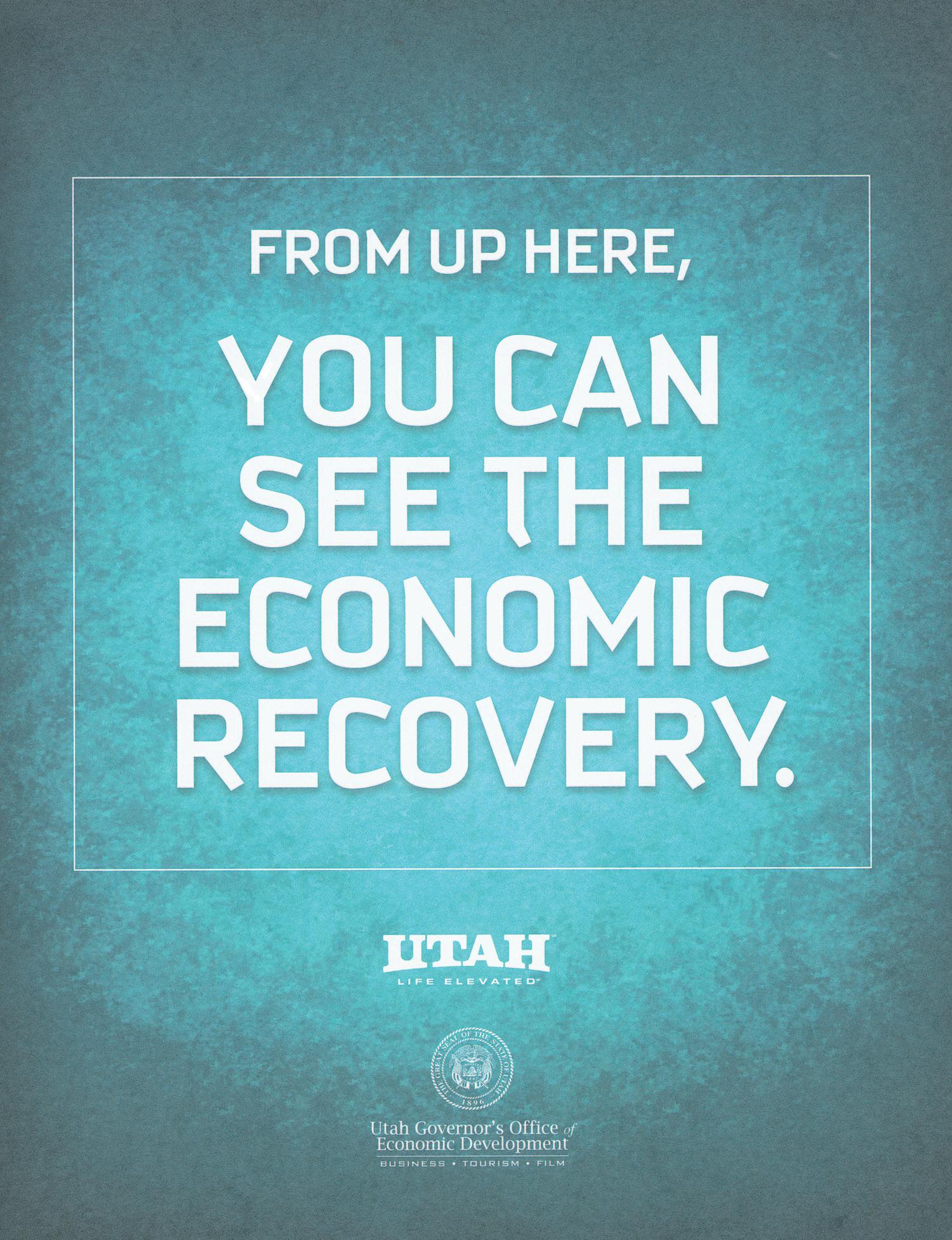
50 Governor’s Office of Economic Development • Annual Report 2010 • www.business.utah.gov
West Coast Initiative
Wall Street Journal ad campaign
•Began mid-March, 2010
•Coordinated with Utah Office of Tourism, Ski Utah, Park City, and Deer Valley —all identified through marketing coordination meetings as being Utah entities that would be advertising in California from March through June 2010. This helped GOED and Richter7 in placing a major media buy for a series of eight one-half page ads in the California edition of the Wall Street Journal.
•Coordinated with all of these partners to get added value placement in scheduling of the ads so that none would overlap, but instead, all of the ads would run consequitively so that print, radio, and television media of California would be saturated with both business marketing messaging and quality of life.
•Results of WSJ ad campaign - Since the beginning of the implementation of the West Coast campaign, web traffic on GOED’s site, www.business.utah.gov , has doubled, and especially out of California where an average of 60 hits a week were coming and now averaging out of California 80 to more than 100 hits per week (see attached graph).
•From the web traffic during the WSJ campaign there were requests by two Califor nia CEO’s for more information about Utah and what the state has to offer in tax structure and incentives. The GOED growth team is working with both of these companies for further information.
DCI PDQ campaign
•Prior to the WSJ campaign DCI had worked and through a series of Predetermined Qualifications indentified 164 companies in the Southern California area that all had connections to Utah, ie. Executives or board members or management employees who were former Utah residents of Utah higher ed alumni, or also determined through media or annual reports were companies looking to move from the West Coast area and that all fall in Utah 7 cluster areas.
•As the WSJ campaign ensued contacts were made with all 164 companies with the intent of setting up a meeting between management and executives from GOED.
•8 meetings were held with two of those actually being on site in California and three here in Utah.
51 Governor’s Office of Economic Development • Annual Report 2010 • www.business.utah.gov
• Results: One company has already moved to Utah—Pleasant Grove—and hired 20 new employees, it is an IT company. No incentives were requested. And another company, with a potential of 300 jobs coming to the state is in the process of applying for an incentive from GOED and the state of Utah.
New PDQ campaign – Northern California
•Just one week ago DCI delivered to GOED a new list of 294 companies, all from the central and Northern California area - that have undergone the same type of PDQ questioning as the previous 264. In one week contacts will begin being made with those in order to set up the process of getting face to face meetings.
For tune magazine wrap
•Beginning this week, 1,100 West Coast CEO’s and 300 site selectors were delivered a special edition of Fortune magazine that has a specific Utah-themed cover page, inside cover pages, inside back page, and back page that all message Utah and the business opportunities afforded in the state.
•Over the course of the next several months, eight more of these Utah-themed wraps will greet the magazine reader as they get their mail. It should be noted that all of these recipients obtained a letter indicating they were going to be getting a six month subscription of the magazine as a gift of the state of Utah and that special messaging would be part of the package. They were given the choice of accepting or rejecting and only 50 turned the magazine with the Utah messaging down.
•These 1,100 will also be personally contacted as the campaign continues.
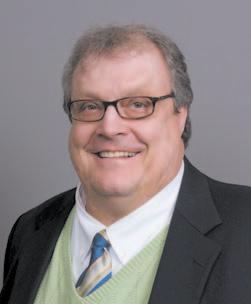
For additional information about the West Coast Initiative visit www.business.utah.gov or contact Clark Caras, GOED Director of Marketing, at chcaras@utah.gov or 801-538-8698.
52 Governor’s Office of Economic Development • Annual Report 2010 • www.business.utah.gov
West Coast Initiative

ECONOMIC DEVELOPMENT PA R TNERS
PA R TNERS
The Governor’s Office of Economic Development Partners
Economic Development Corporation of Utah (EDCUtah)
Manufacturing Extension Partnership
Small Business Development Centers (SBDC)
UGREEN
Utah Fund of Funds
Utah Science Technology and Research Initiative (USTAR)
Utah Sports Commission
World Trade Center Utah
54 Governor’s Office of Economic Development • Annual Report 2010 • www.business.utah.gov
Economic Development Corporation of Utah
OVERVIEW
Economic Development Corporation of Utah (EDCUtah) is an investor-based public/private partnership working with government and private industry to serve as a catalyst for quality job growth and increased capital investment. EDCUtah assists in-state companies to grow and recruits out-of-state companies to expand and relocate in Utah.
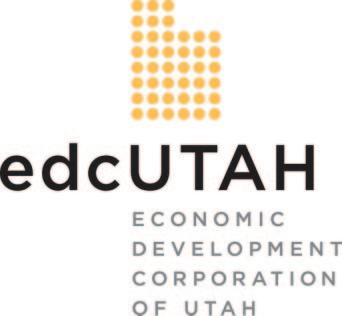
EDCUtah accomplishes its mission by being the comprehensive source for economic data, key public and private contacts, and help through the expansion or relocation process.
The Governor’s Office of Economic Development (GOED) has partnered w ith EDCUtah to handle the state’s business recruitment efforts. This strong partnership has provided great success in recruiting businesses to Utah, and links state government with local government and the private sector in a unified approach to business recruitment. Businesses that visit Utah report that they are impressed with the level of collaboration they experience as they work with the state and local economic development organizations.
Even in a Down Economy, Companies Are Still Choosing Utah
During the 2009-2010 fiscal year, 18 companies have chosen to relocate or expand to Utah. Edwards Lifesciences, O’Reilly Auto Parts, Merit Medical Systems, and Goldman Sachs are prime examples of the quality of such companies.
Edwards Lifesciences, the global leader in the science of heart valves and hemodynamic monitoring chose to relocate its operations to Draper adding more than 1,000 jobs and retaining 228 jobs. The jobs are expected to exceed 125% of the county annual median wage.
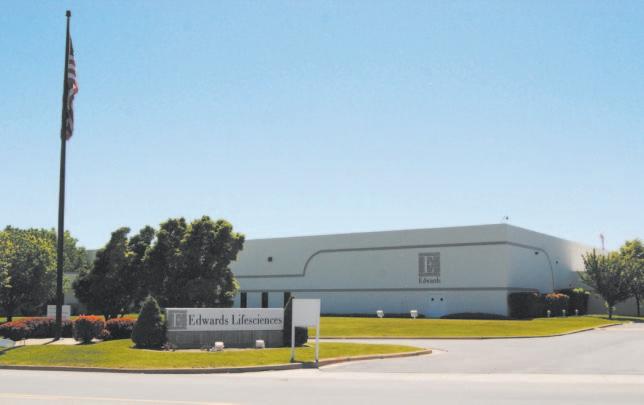
O’Reilly Auto Parts, one of the largest specialty retailers of automotive aftermarket parts, tools, supplies, equipment and accessories in the U.S., has chosen to establish a 200,000-square-foot distribution center in Salt Lake City. The company will hire 450 employees.
Merit Medical Systems, Inc., a leading manufacturer of medical devices used in diagnostic and interventional cardiology and radiology procedures, will expand its facilities and hire an additional 392 employees.
55 Governor’s Office of Economic Development • Annual Report 2010 • www.business.utah.gov
Edwards Lifesciences new facility.
Economic Development Corporation of Utah
Goldman Sachs, a leading global investment banking, securities and investment management firm, has decided to bring an additional 315 jobs to the State. Many of these positions will pay in excess of 150% of the current average wage for Salt Lake County.
EDCUtah worked in partnership with GOED, county and community officials, and the local business community to provide information, incentives, power, transportation access, and assistance to these companies as they came to their final expansion decisions. Many individuals from the community and private business sector came to the table to assist and show support for the projects and to the companies. It was truly a partnership effort.
Results
During the 2009-2010 fiscal year, EDCUtah assisted the following companies that subsequently announced their intentions to expand or relocate in Utah.
• Decho Corporation (dba Mozy Inc.)
• Edwards Lifesciences
• Quality Bicycle Products
• O’Reilly Automotive, Inc.
• Conductive Composites, LLC
• eBay Customer Support Center
• Merit Medical Systems, Inc.
• Semi Service Inc.
• Haemonetics Corporation
• Fairchild Semiconductor
• Lofthouse Bakery Products, Inc.
• Northrop Grumman
• Goldman Sachs
• Midwest Center for Stress and Anxiety
• Green River Capital, LC
• Janicki Industries
• RBS Securities Inc.
• Sutter Physician Services
EDCUtah’s involvement in expansion and relocation projects generally includes many elements such as gathering and consolidating critical economic data, preparing sophisticated economic analyses, organizing and hosting meetings and site visits, connecting clients with key government and private sector individuals and departments, facilitating discussions and negotiations, and helping clients through the entire relocation/expansion process.
EDCUtah has also expanded its national proactive recruiting efforts by creating the new position of Director of Proactive Recruiting which operates out of Southern California. The program has begun to generate targeted leads and projects which EDCUtah is currently managing.

For additional information about the Economic Development Corporation of Utah visit www.business.utah.gov or contact Jeff Edwards, President & CEO, at jedwards@edcutah.org or 801-328-8824.

56 Governor’s Office of Economic Development • Annual Report 2010 • www.business.utah.gov
Goldman Sachs expands operations to 222 S. Main building in Salt Lake City.
OVERVIEW

The MEP of Utah is a non-profit organization that provides assistance to manufacturers throughout the state with services to sustain and improve productivity, expand capacity, enhance grow th and increase profitability. It assesses the individual needs of a manufacturer, identifies the roadblocks to success, opportunities for improvement and growth, and helps the company to leverage private/public resources and to access a consistent set of services to maximize their potential and grow their business.
The MEP is the nation’s champion of manufacturing. MEP Centers are located throughout the U.S. and are affiliates of the National Institute of Standards, U.S. Department of Commerce. Chartered to assist small and medium-sized manufacturers (those employing less than 500 workers), the MEP potential service base includes 99% of the 3,800 manufacturers in Utah. However, MEP has limited resources and less than 5% of the manufacturers have access to MEP in any given year. Those that are assisted by MEP report significant results.
A study of the economic impacts of MEP of Utah prepared by Utah State University shows that MEP served 494 total companies in 2008. Major projects assisted 72 companies reporting measurable impacts. The USU study concluded MEP’s impact on the economy in 2008 to be:
• Additional Wages- $122.5M
• Additional Jobs- 2,992
• Additional Industrial Output- $659.4M
• Additional Indirect Business Taxes- $14.7M
The nature of manufacturing in Utah is diverse, entrepreneurial, and falls under the classification of “small business”. Yet these small companies have large impacts on the state’s economy. Manufacturing provides significant employment with an industry payroll over $5.3 billion-the largest industry payroll in the state-and is one of only 3 industry sectors that employ more than 100,000 Utahns.
Year-to-year manufacturing employment continued to decline during the first 3 quarters of the fiscal year ending June 30. Data for Q4 show a slight rise in em-
57 Governor’s Office of Economic Development • Annual Report 2010 • www.business.utah.gov Manufacturing Extension Partnership
Manufacturing Extension Partnership
ployment to 111,000. Whether the industry has truly hit its floor is yet to be determined. The U.S. economy shows some increased demand for manufactured goods, but it is still weak. Some sectors of the Utah manufacturing economy such as aerospace (especially NASA-linked) face uncertainty in the new fiscal year.
Manufacturing Employment
20 month average: 121,549
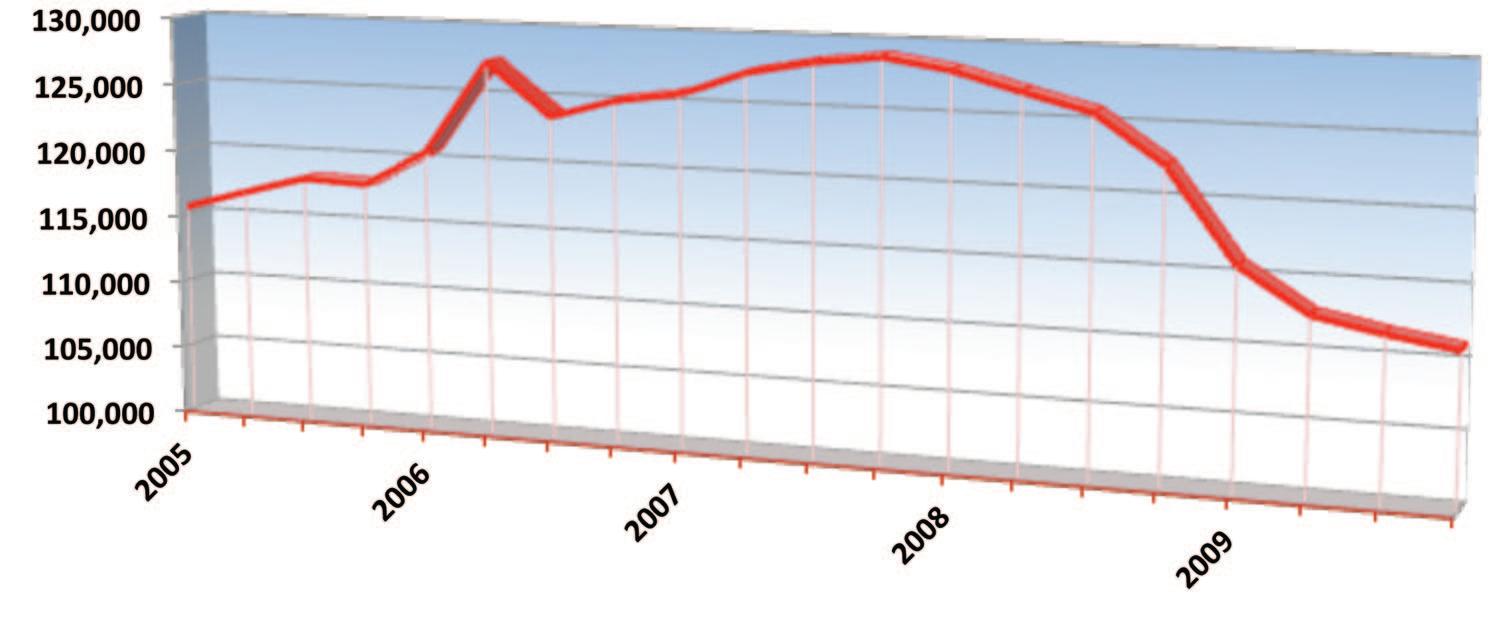
Manufacturing lost 6,581 jobs during the first 3 quarters of FY ending June 2010 before gaining back 1,800 jobs in the last quarter.
Fur ther analysis raises areas of concern. Each of the following shows a small, but steady decline:
•Utah’s manufacturing payroll as a percentage of total state covered payroll
•The percentage of the average manufacturing wage rate above the average state salaried wage for all employment sectors
•Utah’s manufacturing employment as a percentage of total state covered employment
•The number of manufacturing firms is decreasing as a percentage of total firms, and is not keeping up with the pace of the overall economy.
58 Governor’s Office of Economic Development • Annual Report 2010 • www.business.utah.gov

IM Flash Technologies, an Intel-Micron joint venture located in Lehi, Utah, is at the forefront of NAND manufacturing technology. In the three short years since the company was formed, IM Flash has produced the smallest memory chip in the industry, the fastest NAND on the market, and become the third largest manufacturer of NAND in the world. IM Flash was recognized by MEP Utah as the 2009 Manufacturer of the Year for Innovation and Technology Commercialization for processes.
MEP’s mission is to work with existing Utah manufacturers to sustain and improve their productivity, growth and profitability. Profitable Manufacturing Growth has 5 focus areas: 1) Technology Acceleration; 2) Continuous Improvement; 3) Sustainability; 4) Workforce; and 5) Supplier Development. MEP continues to improve and expand its capabilities to serve Utah’s manufacturers. GOED utilizes MEP to promote the economic strength of manufacturing by its inclusion in state, regional, local seminars and conferences, as well as one-on-one referrals to companies seeking assistance.
MEP’s greatest impact is at the enterprise level, where it can work with company owners, managers and workers to assess needs and prepare a plan to meet company-spe-
Manufacturing Statistics
July 2008 – January 2010
Manufacturing Employment 20-month average: 121,548

Manufacturing Monthly Wage 20-month average: $3,645
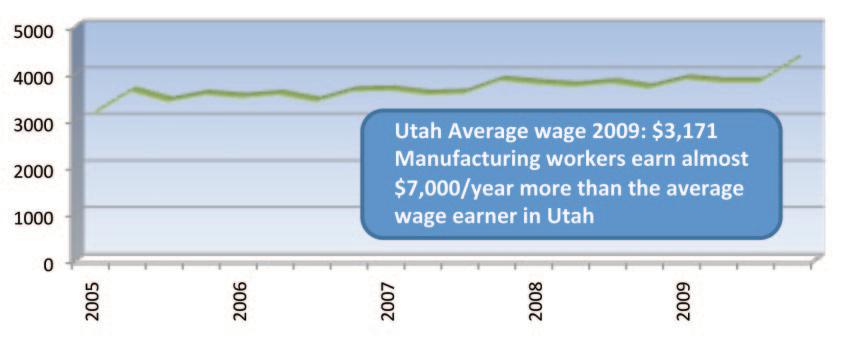
Manufacturing Establishments 20-month average: 3,845
59 Governor’s Office of Economic Development • Annual Report 2010 • www.business.utah.gov Manufacturing Extension Partnership
Manufacturing Extension Partnership
cific issues. MEP services go beyond Lean manufacturing applications and tools. Enterprise development & management and quality management systems are other factors MEP addresses for increased productivity, growth and profitability.
MEP services address company functions across the enterprise, from the front office to the shipping dock. MEP Centers across the country are helping U.S. manufacturers grow and compete globally by applying proven principles to both the bottom line as well as the top line. This makes MEP in Utah more relevant than ever, as Utah manufacturers need to not only cut costs and improve performance, but to define their markets and produce products that differentiate themselves to their consumers. MEP is strategically positioned to work with GOED in the state’s economic development initiatives.
GOED and MEP as partners have not lost sight of the overall importance of manufacturing to the state- its large employee base, livable wages, tax contributions, creation of secondary jobs and a major role in producing most of Utah’s exported goods. MEP will continue to be a resource to the small and mediumsized manufacturers throughout the state and help the entrepreneurial spirit of Utah companies succeed in an ever-changing economy. In both market upturns and downturns, manufacturers face the challenge of differentiating themselves and determining how to bring what is different to the market in a more efficient, costeffective way. As one company official stated, “...MEP has provided our company w ith training that will allow us to succeed...The most exciting part for me, personally, is seeing the excitement of our associates when they catch the vision and see the success...Thanks for all your help. We could not have done it without all the instruction and follow up.”
– Mike Jensen, VP Operations, Ophir-Spiricon, Logan

For additional information about the Manufacturing Extension Partnership visit www.business.utah.gov or contact Stephen Reed, Director of Operations, at sreed@mep.org or 435-797-3789.
60 Governor’s Office of Economic Development • Annual Report 2010 • www.business.utah.gov
Small Business Development Center Network
OVERVIEW
The Utah Small Business Development Center (SBDC) strives to strengthen Utah’s economic fabric and quality of life by facilitating the success and prosperity of small business endeavors. The Utah SBDC network consists of business consultants, trainers, educators and support staff operating statewide from Utah’s state colleges and universities. The Utah host for the SBDC program is Salt Lake Community College, with regional host institutions at College of Eastern Utah (Price and Blanding) Davis ATC, Dixie State College, Snow College (Ephraim and Richfield), Southern Utah University, Utah State University (Logan and Vernal), Utah Valley University, and Weber State University. Other key stakeholders include the US Small Business Administration and the State of Utah Governors Office of Economic Development.

Key goals include providing significant, in-depth, assistance to entrepreneur clients (including pre-startup), that help the client increase sales, profits and jobs, long-term sustainable business practices. This is accomplished through in-depth training, one-to-one no-cost counseling, and following up w ith clients to find the resources that they need.
Two recent successes show the impact that the SBDC can have in the state’s economy.
Lisbon Valley Mining Company Rises from the Dust
San Juan is the largest county in Utah. It’s also the poorest. The population density averages two residents per square mile, bringing the total to a little more than 14,000 souls. A business that employs over 100 men and women—and at a pay scale that is well above average—is a big deal here. When a business is forced to close, it’s a tragedy.
The copper mine and mill began operations in late 2005. By early 2008, management said that the milling operation was taking longer than anticipated, leaving the company unable to meet its delivery obligations.
Robert M. Frayser, General Manager, Lisbon Valley Mining, reflects back that the bank told him to back off of his efforts to save the company—since the potential for a conflict of interest was high. He heeded that request, for a bit, but as the end drew near, he couldn’t maintain that position.
“I realized that my ultimate responsibility as General Manager of Lisbon Valley
61 Governor’s Office of Economic Development • Annual Report 2010 • www.business.utah.gov
was to uphold fiduciary duties as long as I was in the seat. I also thought, “How can I be in a conflict of interest over trying to save the company, if indeed that was my ultimate responsibility anyway?”
Over the next year and a half, Bob put everything he had into saving the company and the jobs it represented.

Lisbon Valley Mining is now the largest private employer in San Juan County. Over 100 men and women are currently on the payroll, and the wages they make are well above average. Had it not been for the grit and determination shown by Bob Frayser, the company would have gone from 35 employees at the first of 2009 to zero employees at the Lisbon Valley site. The bank would have liquidated the assets and the region, already hard hit and struggling, would have seen an exodus of workers who would have been forced to go elsewhere in search of a job.
Bob Frayser and his management team, working under the premise that better results require better actions, formulated an operating plan that has turned the mine from a losing proposition to a profitable enterprise.
“Mining costs were originally estimated at $1.98 per ton mined compared to future and planned mining cost of $0.91 per ton mined. This is a result of changes related to ore handling, blasting operations, and the elimination of the primary and secondary crushing and conveying circuits.”
Management reviewed the operations from start to finish evaluating different mining scenarios, project improvements, and cost control alternatives. Below are just a few of the innovations he implemented at the mine:
•The elimination of costly and ineffective crushing and conveying circuits.
•A smaller capacity, but more effective and efficient haul trucks.
•Modified drilling and blasting function, for higher impact.
•A reduction in waste haul distance.
•Restructured management functions for lower costs and better performance.
Extensive and detailed due diligence work has validated management’s efforts towards becoming a viable company resulting in a positive impact to local communities, counties, and the State of Utah.
62 Governor’s Office of Economic Development • Annual Report 2010 • www.business.utah.gov
Small Business Development Center Network
Small Business Development Center Network
The Blanding SBDC provided the initial contact that led to new equity funding that saved the company and over 100 jobs.
Robert Frayser was named the SBA 2010 Small Business Person of the Year for the Utah District.
Panoptic Security Wins Global Product Award

Panoptic Security first visited the Sandy SBDC in March 2007. They were contemplating what has today become a highly successful company that employs 12 people and is growing revenue by over 500% annually. With the advice and assistance of several experienced SBDC consultants, Panoptic Security has successfully grown into one of the industry’s leading security and compliance solution providers.
Panoptic Security is a technology security company that specializes in Payment Card Industry (PCI) compliance programs for small and mid-size merchants, ISOs, Acquiring Banks and credit card processors. The executive team includes some of the security industry’s leading technologists and PCI compliance experts.
The Panoptic Security ExpertPCI™ online web application enables merchants to assess their PCI compliance and take steps to ensure they can mitigate data breaches and securely handle credit card transactions.
Merchants can access the ExpertPCI™ application and quickly determine the rig ht PCI Self Assessment Questionnaire (SAQ) appropriate for their business and generate the necessary documentation. That documentation includes a completed SAQ, PCI compliance validation and reporting, a custom remediation plan, and a custom security policy.
ISOs, Acquiring Banks and credit card processors can work directly with Panopt ic Security to ensure all of their merchants have the best online solution available to assess each merchant’s PCI compliance condition. Panoptic Security offers simple, and easy to implement, packages for their partners so they can quickly and efficiently assist their merchants with PCI compliance.
Tim Cranny, CEO, is a global leader in the information security space, having played key strategic and technical roles in a variety of high-tech startups. He has worked extensively and directly on cutting-edge technology, and has long experience in embedding technology in its strategic and business context. Tim has worked extensively as consultant of security issues, having spoken at dozens of international conferences and written many whitepapers and journal articles.
Panoptic Security’s ExpertPCI™ was recently nominated and won the 2010
63 Governor’s Office of Economic Development • Annual Report 2010 • www.business.utah.gov
Small Business Development Center Network
Global Product Excellence Award in the compliance category. Info Security Products Guide, the world’s leading publication on security-related products and technologies, based the award on the company’s innovative performance and unique product. Info Security Product Guide awards recognize security and IT vendors for advanced, ground-breaking products and solutions that are helping set the bar higher.
“Winning the Global Product Excellence Award is a testament not only to our product,ExpertPCI™, but also to the dedication to our incredible team,” said Dr. Tim Cranny, CEO of Panoptic Security. “We are honored to be recognized for our product innovation and are looking forward to continuing to make strides in helping companies achieve PCI compliance faster and easier.”
“ The SBDC provided us with a first home just when we needed it,” Cranny said. “The range of advisors and services it provided was extremely useful for us, and helped us with those first steps. They definitely contributed to our current continuing success.”
Panoptic Security is a graduate of the Miller Business Resource Center business incubator.
SBDC Business Counseling Hours for ‘07-2010 SFYs

SBDC Counseling Benefits for ‘07-2009 FFYs reported in the Economic Impact of Small Businesses Development Center Counseling Activities in Utah
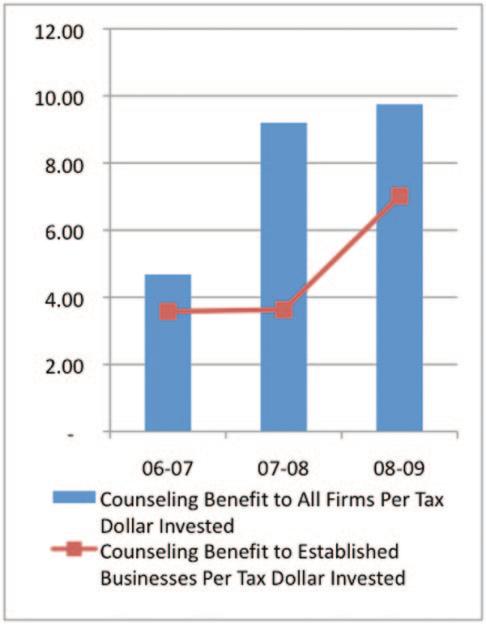
SBDC Client Annual Capital Infusion and Business Starts

For additional information about the Small Business Development Center Network visit www.business.utah.gov or contact Greg Panichello, State Director, at greg.panichello@slcc.edu or 801-957-5381.
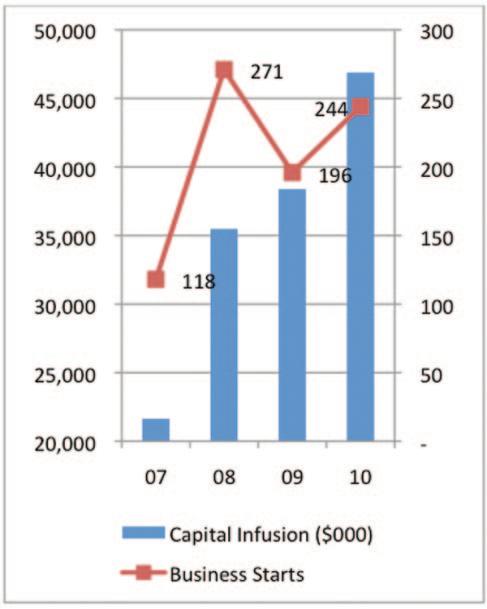
64 Governor’s Office of Economic Development • Annual Report 2010 • www.business.utah.gov
The Utah Generated Renewable Energy Electricity Network Authority
OVERVIEW
The Utah Generated Renewable Energy Electricity Network Authority (UGREEN) was created by the 2009 legislature to provide a mechanism for financing renewable energy transmission projects in the State of Utah. UGREEN is housed within GOED and works closely with the State Energy Program and the Governor’s Energy Advisor’s Office to ensure efficiency, efficacy, and comprehensive coverage of renewable energy issues in the State.
The Board appointed a Special Advisor to in the spring of 2010 and the Authority is moving forward with establishing the organizational and structural framework within which it will operate. In early July, UGREEN issued its first Letter of Support to PurpleEnergy, a company seeking a federal grant to explore hybrid geothermal/solar thermal technologies in southwestern Utah. Over the next year, UGREEN will continue to interact with high caliber companies seeking to develop renewable energy infrastructure in Utah and provide support for their transmission needs as appropriate. In addi(continued on next page)

65 Governor’s Office of Economic Development • Annual Report 2010 • www.business.utah.gov UGREEN
UGREEN
The Utah Generated Renewable Energy Electricity Network Authority
tion, UGREEN will collaborate with other western State Infrastructure Authorities to create a coalition to further the mutual interests of the group. UGREEN will be the inaugural host of the annual event this September and this year’s agenda will focus on federal tax exemption for authority revenue bonds and the positive impacts that would accrue to developers and the State. Finally, Governor Herbert’s Energy Initiative Task Force has nominated UGREEN to serve as staff to the Transmission, Infrastructure and Transportation Subcommittee. UGREEN will be intimately involved in drafting the Governor’s 10 Year Strategic Energy Plan and looks forward to helping shape Utah’s energy landscape in ways that benefit the citizens, the environment, and the economy.


For additional information about UGREEN visit www.business.utah.gov or contact Yashoda Khandkar, Special Advisor, at ykhandkar@utah.gov or 801-580-6519.
66 Governor’s Office of Economic Development • Annual Report 2010 • www.business.utah.gov
Utah Fund of Funds
OVERVIEW
The Utah Fund of Funds (UFOF) is a major economic development program created by the Utah legislature to provide the state’s entrepreneurs with access to a broad array of quality funding sources. With a charter of $200 million approved in 2008 the fund invests in quality venture capital/private equity funds, which in turn explore investments in promising Utah Entrepreneurial growth companies.

As of July 2010 more than 500 funds had applied to the Program, from which 28 high-quality venture capital/private equity firms had been selected as portfolio firms, including 8 from Utah. Partners at out-of-state firms commit to spend a predetermined amount of days in Utah, Helping the fund build a strong network of Utah Business leader, entrepreneur and companies.
The UFOF also conducts a number of economic development training and networking events including the annual Utah Fund of Funds Medical Device Symposium and the Annual Utah Fund of Funds Middle Market Symposium. The Medical Device symposium presented each spring, attracts world class investors, innovators, physicians and students. The panels focus on fund raising. Attendance for the second year, April 2010, was nearly twice that of the first and the event expanded to include vendor booths and sponsors. Feedback has created a buzz for next year which may include adding diagnostics to the focus. One of this year’s sponsors, Nelson Labs President Jeff Nelson expressed “It is great to have such a powerful tool in the state with the Fund of Funds.”
This year’s 6-part training on How to Fund Raise from Institutional investors presents a topic each month at the Miller Innovation Center. Feedback has been tremendous, including comments from entrepreneurs who explain that the information in the presentations was critical and they left each session with lists of tasks they are determined to complete. These presentations are being filmed and are available via webstream.
The UFOF is hungry for new opportunities and looks to advance its presence w ith established companies. In order to create portfolio diversification, the UFOF is increasing its investment portfolio allocation in the buyout industry. In September the UFOF will present our second annual Middle Market Symposium. The 201-event will be sponsored by five leading buyout firms: Fenway Partners, Sorenson Capital, Marwit Capital, Seidler Equity Partners and Peterson Partners. CEOs of
67 Governor’s Office of Economic Development • Annual Report 2010 • www.business.utah.gov
Utah Fund of Funds
Utah companies with revenue greater than $5 million are invited to spend the day learning about the buyout industr y and current trends, and to network w ith buyout professionals and other well-known CEOs. The UFOF is confident this symposium creates strong opportunities for established companies to continue to grow in Utah.
In addition to facilitating direct investments into Utah companies, the UFOF has experienced strong intangible success. It is difficult to quantify the value of educating Utah companies about private equity funding and prov iding them with private equity relationship opportunities, but feedback from Utah companies, investors and universities has been positive.
SUCCESS
Thus far in the program, Utah FoF portfolio firms have completed 912 in-depth reviews of Utah companies and selected 40 to receive funding. Over $249 million has been invested in these companies from the UFOF portfolio, and the portfolio firms have helped them raise over a $1 billion with Fund of Funds portfolio and additional syndication. Most importantly, these 40 companies have created a total of 3449 jobs, with an annual average salary of approximately $66,000—far above the Utah average wage.
“Just wanted to drop you a note and thank you again for the Utah FoF introduction to Alliance Health Networks. I have attached the news release about their funding for your reading pleasure.”
– Phil Reed, Highway Ventures
“We hosted a group from Oregon the first of the week. One of the individuals told me he had been analyzing the effectiveness of Fund of Fund efforts and that Utah had much superior results to Oregon. I asked him to send me the comparison, which he did. [There are] (s)ome interesting ways of looking at the Fund of Funds outcomes, and all positive for Utah. … it is encouraging to see that the Fund of Funds mechanism can be effective.”
– Jack Brittain, University of Utah.
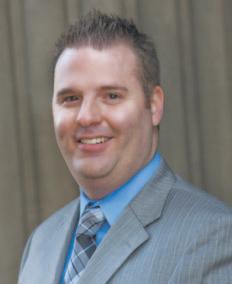
For additional information about the Utah Fund of Funds visit www.business.utah.gov or contact Matt Peterson, Vice President, at matt@utahfof.com or 801-931-4557.
68 Governor’s Office of Economic Development • Annual Report 2010 • www.business.utah.gov
Utah Science Technology and Research Initiative
OVERVIEW
The Utah Science Technology and Research initiative (USTAR) is a long-term, state-funded investment to strengthen Utah’s “knowledge economy” and generate high-paying jobs. Funded in March 2006 by the State Legislature, USTAR is based on three program areas. The first area funds strategic investments at the University of Utah and Utah State University to recruit world-class researchers. The second area is to build state-of-the-art interdisciplinary facilities at these institutions for the innovation teams. The third program area involves teams that work with companies and entrepreneurs across Utah to promote technology commercialization.
Research Teams

Nearly 40 leading researchers from around the country have been recruited to Utah since USTAR’s inception, and recruitment continues. Strategic innovation focus areas include:
• Energy – Conventional and Alternative
•Biopharma/Biodevice
•Medical Imaging and Brain Medicine
•Imaging Technology and Digital Media
•Nanotechnology
Based on preliminary data for fiscal years 20072010 combined, USTAR research teams have attracted federal and other extramural funding to the state at nearly twice the rate projected in USTAR’s 2005 economic prospectus. Detailed data will be posted at http://www.innovationutah.com.
Some research highlights include:
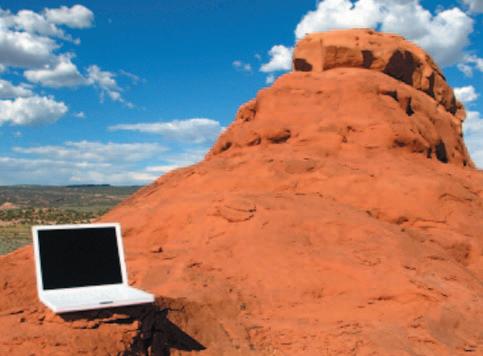
Collaborating with other Southern Utah economic development stakeholders, USTAR was instrumental in launching the Information Technology and Renewable Energy business incubator in St. George.
•In the last year, USTAR researchers Massood Tabib-Azar (U of U) and Ken Tobiska (USU) have started or relocated companies to Utah.
• HCCS, a U of U/Headwaters, Inc. joint venture based on research by Brian McPherson, is performing a $2.7 million study of carbon dioxide management for a Midwest-based ethanol plant. McPherson is considered one of the world’s leading experts on carbon sequestration of greenhouse gases.
69 Governor’s Office of Economic Development • Annual Report 2010 • www.business.utah.gov
Utah Science Technology and Research Initiative
• USU’s Synthetic Bio-Manufacturing Center has developed more 50 specific genetic pathways to “teach” single-cell organisms to produce useful compounds using only sunlight and carbon dioxide. Bioplastics, agrichemicals, and pharmaceutical products are some the markets the Center is targeting.
•A researcher at the U of U’s Brain Institute, USTAR’s Julie Korenberg led a multiinstitution team that identified a single gene that appears to determine intelligence in Williams Syndrome patients. The study has implications for the general population.
• USU’s Center for Advanced Sensing and Imaging has performed two industrial cleantech studies using laser-based technology. One study used “wind mapping” to site wind farm towers for highest performance. The other is helping an oil developer in the Uintah Basin manage processed water ponds to reduce potential air pollutants.
Research Buildings
USTAR funding supports construction of state-of-the-art interdisciplinary research and innovation facilities at the U of U and USU. Each will provide research teams with strategic core facilities to advance innovation and commercialization in their respective focus areas. These facilities are designed to be “industry magnets” for innovation collaboration.
The 110,000 square foot USU building will have a ribbon cutting ceremony in October 2010 and house a Biosafety Level 3 laboratory to perform advanced research in veterinary diseases and other life science projects. At the U of U, the 200,000 square foot facility is on track for a 2012 opening, and will contain one of nation’s most advanced nanofabrication facilities.
The building projects have been a bright spot on the employment front, utilizing more than 800 construction workers at the two sites throughout 2010.

The USTAR building at USU is opening in October 2010. The structure adds 110,000 square feet of premium life science lab space to the state’s “innovation infrastructure.” Multiple USTAR research teams will share the building, increasing the opportunities for creative collaboration.
70 Governor’s Office of Economic Development • Annual Report 2010 • www.business.utah.gov
P hoto by Jared Thayne
Utah Science Technology and Research Initiative
Technology Outreach Program
USTAR’s Technology Outreach Innovation Program is the engine to drive commercialization activities. Technology Outreach teams work with entrepreneurs, emerging and established businesses, academic researchers, and other innovation economy stakeholders across the state. Experienced team members are based at Weber State University, Utah Valley University, USU - Uintah Basin, Dixie State College and Southern Utah University.
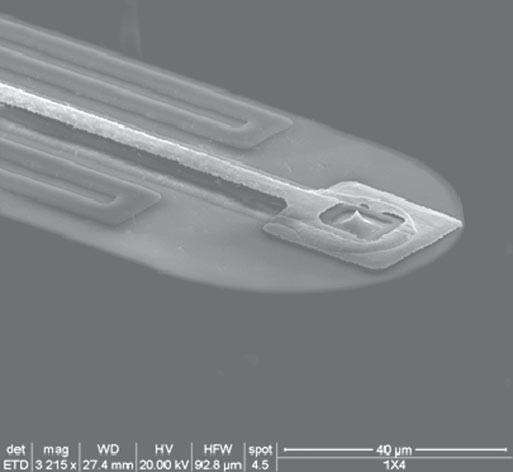
The U of U’s Wireless Nanosystems team is developing a “nanotorch” for use in manufacturing smaller, more powerful electronics such as circuit boards.
USTAR Technology Outreach teams completed projects with more than 175 companies and entrepreneurs in FY2010, including assistance in marke t analysis, market entry, prototyping, and fundraising. Since inception, the Technology Outreach team has helped innovators raise more than $30 million in private equity.
In perhaps what is a best practice in use of federal stimulus funds, Technology Outreach launched in the last year the Technology Commercialization Grant program. Today, 68 projects at higher education institutions around the state are fast-
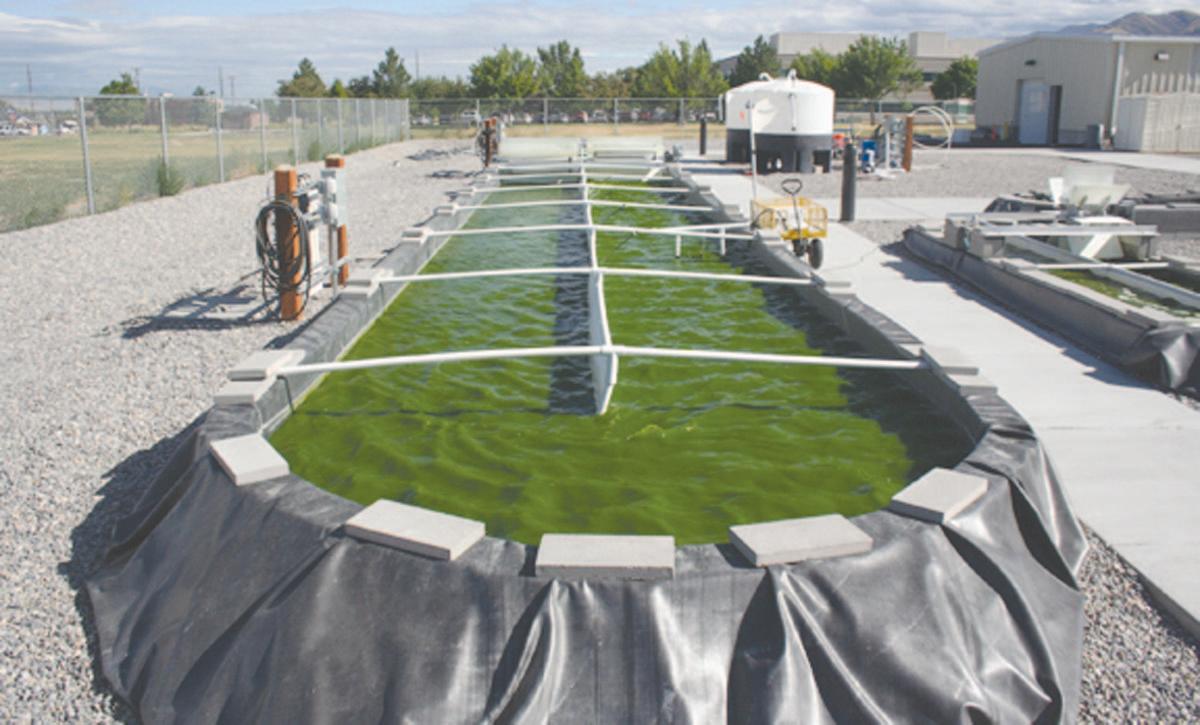
USU’s Biofuels program has opened one of the most advanced research facilities in the country.
71 Governor’s Office of Economic Development • Annual Report 2010 • www.business.utah.gov
Utah Science Technology and Research Initiative

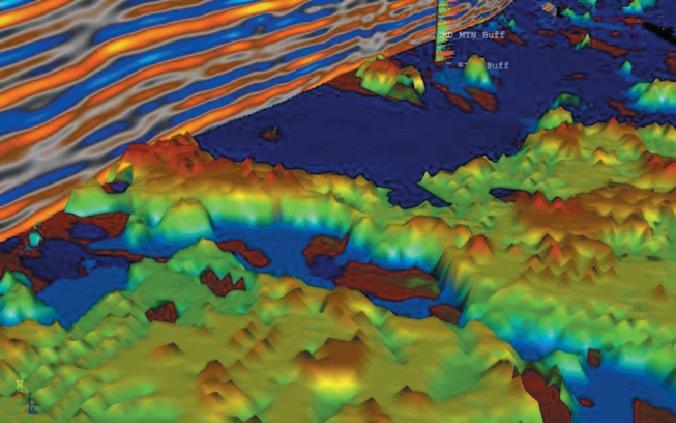
tracking technologies to the market, including the filing of more than 20 new patents and disclosures and development of more than 15 new prototypes. These projects range from $12,000 to $90,000 in funding, and most have an industry co-applicant, evidence that “town and gown” can work together to boost regional economies.
In the recent past, USTAR helped launch two incubators—the BioInnovations Gateway in Salt Lake City and the Information Technology and Renewable Energy center in St. George—as well as the SBIR-STTR Assistance Center at SLCC’s Miller Campus. In addition, USTAR contributed significant funds to help the U of U launch a new bioscience business incubator.
For more information, visit www.innovationutah.com or follow USTAR at http://twitter.com/innovationutah.

The U of U’s new life sciences business Accelerator facility is opening in the Fall 2010 thanks in part to a significant contribution from USTAR.
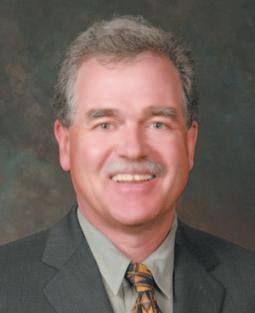
For additional information about the Utah Science Technology and Research Initiative visit www.business.utah.gov or contact Michael O’Malley at ustarinfo@utah.gov or 801-538-8879.
72 Governor’s Office of Economic Development • Annual Report 2010 • www.business.utah.gov
A USTAR-funded project at the U of U’s Energy & Geosciences Institute may help Utah oil and gas developers increase drilling accuracy, reducing production costs and lessening environmental impacts.
OVERVIEW
The mission of the Utah Sports Commission is to help enhance Utah’s economy, image and quality of life through the attraction, promotion and development of national and international sports.

Executive Summary
Since its creation prior to the 2002 Olympic Winter Games, Utah has positioned itself as a leader in sports event attraction and sports related travel through the Utah Sports Commission. Assisted by the state-wide partners of TEAM UTAH, the Utah Sports Commission has helped to secure hundreds of professional and amateur sporting events that continue to produce economic development and branding for the state and its communities.

The 2002 Olympic Winter Games established Utah as a world-wide leader in winter sports and a preferred travel destination. The vision of the Utah Sports Commission has been to continue the Olympic legacy that was established and grow additional sports genres. Utah is unique in that its varied landscapes, venues, and manmade and natural amenities can accommodate a wide range of sporting events. From the Red Bull Air Race through the Mittens in Monument Valley, to the St. George IronMan Tr iathlon, to the internationally viewed FIM Hannspree Superbike event in Tooele County, and the iconic DewTour in Salt Lake City, the state of Utah has benefited fiscally by sporting events. Equally, sporting events and access in Utah help bolster the quality of life that Utah enjoys.
The Utah Sports Commission and our partners with TEAM UTAH will continue to grow the nearly $6 billion dollar sports industry in Utah by actively recruiting, and helping to produce viable sporting events. The following information highlights the 2009-2010 Fiscal Year and provides an aggregate accounting of the impact of sporting events brought to Utah by the Utah Sports Commission and TEAM UTAH.
73 Governor’s Office of Economic Development • Annual Report 2010 • www.business.utah.gov
Utah Sports Commission
Summer DewTour 2009 downtown Salt Lake City.
2009-2010 KEY HIGHLIGHTS
•Partnered in 37 sporting events across the state generating approximately $135 million in direct economic impact to Utah
•Partnered with 17 nationally or internationally televised events that provided Utah with approximately $51 million in media value
•Negotiated the return of Monster Energy AMA Supercross back to Rice-Eccles Stadium bringing an estimated $9 million in economic impact and $2 million in media value to the state
•Negotiated the return of the Winter Dew Tour for the 2011 season and established Snowbasin Resort and the Utah stop the season ending Championship. The 2010 event brought an estimated $5 million in economic impact and $5 million in media value to Utah

• Organized a Governor’s Delegation which attended the 2010 Vancouver Olympic Winter Games meeting with members of the IOC, USOC and others in the Oly mpic Family
• Organized a Governor’s Olympian Recognition Luncheon honoring those Olympians that either live or train in Utah
•Continued to evolve and build Utah’s Destination Golf program which included 2 “fam” trips for golf magazine writers, which resulted in a magazine article on golf in Utah
•Utah continued to play host to the Utah Championship bringing an estimated $4 million in economic impact to Utah and 20 hours of GOLF CHANNEL coverage which is the cornerstone of Utah’s Destination Golf program.
•Worked with Red Bull to bring the Red Bull Rampage back to southwest Utah, which is the largest mountain biking competition staged with national and international television, including NBC which will bring approximately $2-3 million in economic impact to Utah
74 Governor’s Office of Economic Development • Annual Report 2010 • www.business.utah.gov
Utah Sports Commission
Winter DewTour 2010 Snowbasin Resort.
Utah Sports Commission
•Assisted with arranging for Film Commission funding for Godfrey Productions to ensure they remain a Utah company
•Negotiated the return of the XTERRA USA National Championship to be held at Snowbasin Resort. The event is estimated to bring approximately $2 million in economic impact and $3.5 million in media value to Utah. The event is the largest off-road triathlon of its kind

•Partnered w ith Rio Tinto Stadium to bring the Amsoil Western Nationals Snocross & Freestyle event to Utah bringing an estimated $2 million in economic impact and $1 in media value. The 2010 Utah event won ISOC Racing’s series “Event of the Year”. Currently in the process of securing event for 3 years.
•Partnered with MMSP and sponsored the FIM World Superbike Championship with a projected economic impact of $16 million and $17 million in media value
•Negotiated to secure the return of the 2010 Summer Dew Tour
•Set up Twitter and Facebook accounts utilizing social networking for marketing purposes
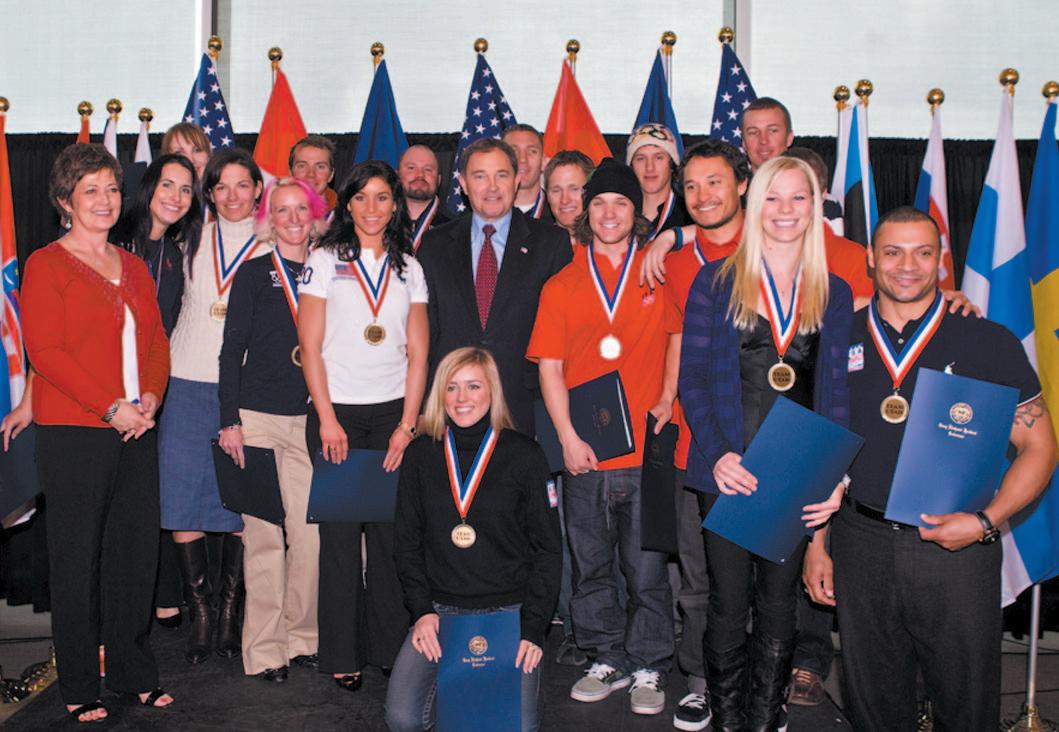
75 Governor’s Office of Economic Development • Annual Report 2010 • www.business.utah.gov
Snocross 2010 Rio Tinto Stadium, Sandy.
Governor’s Olympic Recog nition Luncheon.
Utah Sports Commission
$7.4 TO $13.1 MILLION
APPROXIMATE TOTAL TAX REVENUE COLLECTED FROM SPORT RELATED EXPENDITURES (DIRECT & INDIRECT)
4.340 TO 7.630
APPROXIMATE TOTAL JOBS CREATED FROM SPORT RELATED EXPENDITURES (DIRECT & INDIRECT)
5.4:1 TO 9.6: 1
APPROXIMATE RETURN ON INVESTMENT FROM ACTUAL TAX REVENUE COLLECTED COMPARED TO STATE DOLLARS RECEIVED
$126 MILLION
APPROXIMATE DIRECT ECONOMIC IMPACT TO UTAH
$218 MILLION
APPROXIMATE TOTAL ECONOMIC IMPACT WITH GOBP MULTIPLIER
$91 : $1 Direct•$160 : $1 Total RETURN ON INVESTMENT
FROM EVENTS HOSTED VS. STATE DOLLARS RECEIVED (Direct Economic Impact vs. Total Economic Impact w/Multiplier per GOBP)
$1.3 MILLION
APPROXIMATE NON-STATE FUNDS AND VALUE IN KIND SERVICES RAISED OR LEVERAGED
37
NUMBER OF UTAH SPORTS COMMISSION PARTERNED EVENTS
$59 TO $115 MILLION
APPROXIMATE TOTAL TAX REVENUE COLLECTED FROM SPORT RELATED EXPENDITURES (DIRECT & INDIRECT)
34,650 TO 67,000
APPROXIMATE TOTAL JOBS CREATED FROM SPORT RELATED EXPENDITURES (DIRECT & INDIRECT)
5.3:1 TO 10.1:1
APPROXIMATE RETURN ON INVESTMENT FROM ACTUAL TAX REVENUE COLLECTED COMPARED TO ACTUAL STATE DOLLARS RECEIVED (DIRECT & INDIRECT)
$1.8 BILLION
APPROXIMATE TOTAL ECONOMIC IMPACT WITH GOBP MULTIPLIER FROM HOSTING EVENTS FROM 2000-2014
$1.08 BILLION
APPROXIMATE DIRECT ECONOMIC IMPACT FROM HOSTING EVENTS
$70:1 TO $120:1
APPROXIMATE ROI FROM EVENTS HOSTED COMPARED TO ACTUAL STATE DOLALRS RECEIVED (DIRECT & INDIRECT)
$9.1 MILLION
APPROXIMATE VALUE OF NON-STATE FUNDS/VALUE-INKIND RAISED AND/OR LEVERAGED TO ENHANCE STATEWIDE SPORTS DEVELOPMENT EFFORTS

For additional information about the Utah Sports Commission visit www.business.utah.gov or contact Jeff Robbins, President and CEO, at jlrobbins@utah.gov or 801-328-2372.
28
EVENTS WHICH RECEIVED FUNDING/GRANTS
12
CITIES IMPACTED THROUGHOUT UTAH
OVER 100
TOTAL NUMBER OF EVENT INQUIRIES 2009-2010
$51 MILLION
VALUE OF TELEVISION & OTHER MEDIA ASSETS FROM EVENTS HOSTED IN OR ASSOCIATED WITH UTAH
$1.7 MILLION
GRANTS & SPONSORSHIP PROVIDED TO HOSTED/ PARTNERED EVENTS
$450,000
APPROXIMATE MARKETING, ADVERTISING AND TOURISM RELATED RESOURCES USED IN THE PROMOTION OF UTAH
500
APPROXIMATE VOLUNTEERS PROVIDED TO EVENTS FROM 2002 LEGACY DATABASE
20 HOURS
TV COVERAGE OF UTAH’S ONLY
PGA TOUR SANCTIONED EVENT TO PROMOTE DESTINATION GOLF, TOURISM & SPORT DEVELOPMENT ESTIMATED ECONOMIC IMPACT & COMBINED MEDIA
VALUE OF $3-4 MILLION
377
EVENTS LANDED OR PARTNERED WITH “TEAM UTAH” 2000 -2010 INCLUDING EVENTS COMMITTED THRU 2014
26
CITIES IMPACTED THROUGHOUT UTAH
OVER 1,050
TOTAL NUMBER OF EVENT INQUIRIES
232
EVENTS RECEIVED GRANTS/FUNDING
$7.01 MILLION
GRANTS & SPONSORSHIP PROVIDED TO HOST EVENTS
$150 MILLION
APPROXIMATE VALUE OF NATIONAL/INTERNATIONAL TELEVISION & OTHER MEDIA ASSETS FROM EVENTS HOSTED IN/ASSOCIATED WITH UTAH
$3.45 MILLION
APPROXIMATE MARKETING, ADVERTISING & TOURISM RELATED RESOURCES USED IN THE PROMOTION OF UTAH AND ATTRACTING SPORTING EVENTS
10,000
NUMBER OF VOLUNTEERS MANAGED IN THE OLYMPIC LEGACY DATABASE
1,300 HOURS
APPROXIMATE HOURS OF BROADCAST COVERAGE OF EVENTS HELD IN UTAH
80 HOURS
TV COVERAGE OF UTAH’S ONLY PGA TOUR SANCTIONED EVENT TO PROMOTE DESTINATION GOLF, TOURISM & SPORT DEVELOPMENT ESTIMATED ECONOMIC IMPACT AND COMBINED MEDIA VALUE OF $3-4 MILLION PER EVENT
76 Governor’s Office of Economic Development • Annual Report 2010 • www.business.utah.gov
UTAH
COMMISSION
UTAH • Impact on the State
Utah 2000-2014
UTAH • Impact on
2009-2010
SPORTS
& TEAM
of
UTAH SPORTS COMMISSION & TEAM
the State of Utah
OVERVIEW
The mission of the World Trade Center Utah (WTCU) is to guide Utah companies into profitable international markets. Together with our key international partners -we have expanded the valuable worldwide network based on Utah’s unique cultural, educational, economic, and foreign language capabilities. World Trade Center Utah is an ideal catalyst for increased—and profitable—international trade.
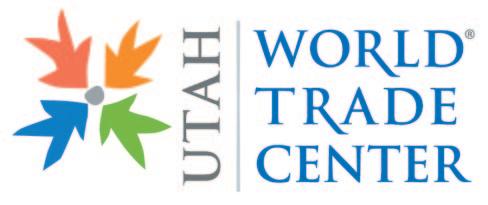
Utah had an outstanding 2010 export year—the only state in the U.S. that showed positive growth in export performance—a clear demonstration of the effectiveness of Utah’s efforts to promote international trade!
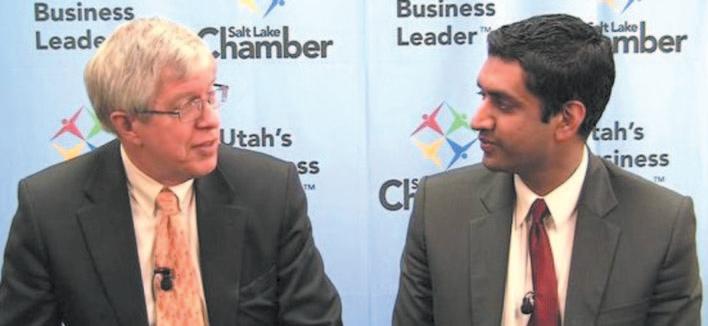
Lew Cramer, President & CEO, WTCU and Ro Khanna, Deputy Asst. Secretary for Domestic Operations, U.S. Commercial Service.
In 2009/2010, WTCU had a very productive year with over 500 clients served through a variety of international business development sessions and co-sponsorship of international diplomacy events involving ambassadors and senior ranking economic development officials from all continents.
WTCU offers a three-step Signature Service that streamlines assistance to Utah companies:
Assess
WTCU offers in-depth assessment services to Utah companies in over seven industry clusters. Interested company representatives can begin by contacting the WTCU directly or completing our on-line form. After the assessment interview, WTCU offers advice, educational seminars, and networking opportunities to assist the client with their international expansion.
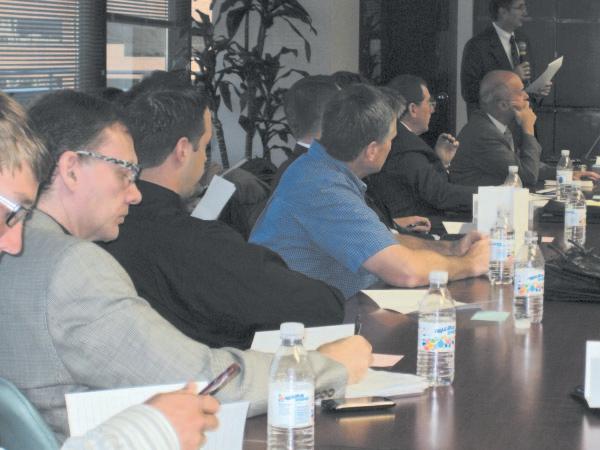
Educate
WTCU, along with our strategic partners, GOED, U.S. Commercial Service, and the Salt Lake Chamber—co-hosted a wide range of educational events such as:
77 Governor’s Office of Economic Development • Annual Report 2010 • www.business.utah.gov World Trade Center Utah
World Trade Center Utah
•I nternational Networking Seminar
•China Supply Management
•Thailand and UK Board of Investments
•Automated Export System
•International Mediation & Arbitration
• IT & Life Science Opportunities in Canada
Connect
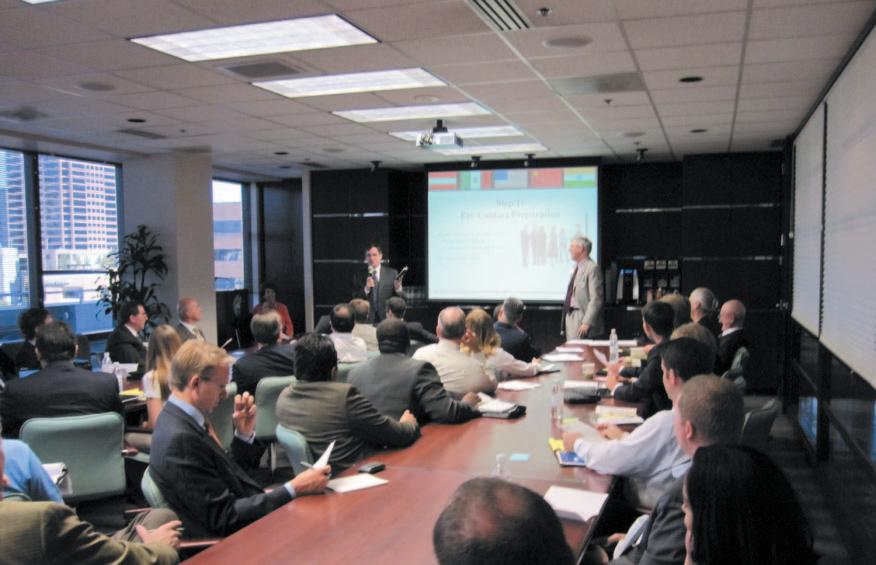
In addition to facilitating connections through educational events, WTCU assists our clients by linking them with credible, relevant resources for conducting their international business. With well over 5,000 contacts, WTCU can help clients link regionally, nationally and internationally with industry partners, service providers and essential contacts.
Global Utah
Our weekly email newsletter includes the essential International Calendar and key articles on international business. To subscribe to Global Utah, v isit our website at www.wtcut.com.
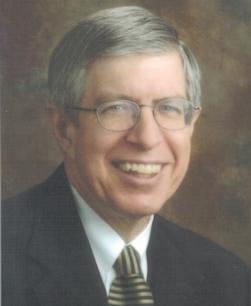
For additional information about the World Trade Center Utah visit www.business.utah.gov or contact
Lew Cramer, President and Chief Executive Officer, at lcramer@wtcut.com or 801-532-8080.
78 Governor’s Office of Economic Development • Annual Report 2010 • www.business.utah.gov

ECONOMIC DEVELOPMENT RESOURCES
RESOURCES
80 Governor’s Office of Economic Development • Annual Report 2010 • www.business.utah.gov
Southern Utah University (SUU) Business Resource Center
77 North Main Street, Cedar City, Utah 84720
1-435-586-8883
1-435-865-7707
• andersonjoni@suu.edu
• isom@suu.edu
1-435-586-4310 FAX
• Joni Anderson
• Craig Isom
North Front Business Resource Center
450 S. Simmons Way, Suite 100, Kaysville, Utah 84037
1-801-593-2104
• mrhoxer@datc.edu
• Marnae Hoxer www.datc.edu/employers/davis-business-alliance
Utah Valley University (UVU) Business Resource Center
800 West University Parkway, 239, Orem, Utah 84058-5999
1-801-863-8230
1-801-863-8231
• karenw@uvu.edu
• www.uvu.edu/brc/
• Karen Wenn
The Miller Business Resource Center
9750 S. 300 W., Sandy, Utah 84070
801-957-5279
Rex Falkenrath
• www.slcc.edu
Dixie Business Alliance
Dixie State College, 225 S. 700 E., UHB #127
St. George, Utah 84770
1-435-652-7741
• sbdc@dixie.edu
Cache Business Resource Center
• Len Erickson
Bridgerland Applied Technology College
1410 N. 1000 W., Logan, Utah 84341
1-435-213-8713
• (BATC) West Campus
• croberts@cachebrc.com
• Cindy Roberts www.cachebrc.com
Business and Technical Assistance Center
Carbon & Emery County
375 S. Carbon Ave., Price, Utah 84501
1-435-636-3295
• Dpaletta@seualg.utah.gov
• Paletta Delia www.btacenter.com
Tooele County Business Resource Center
47 South Main Street, Tooele, Utah 84074
1-435-843-3129
• NCline@co.tooele.ut.us
• Nicole Cline www.tooeleeconomicdevelopment.com
PRIVATE SECTOR BRC
Zions Bank Business Resource Center
310 South Main, Mezzanine
Salt Lake City, Utah 84101
801-594-8245
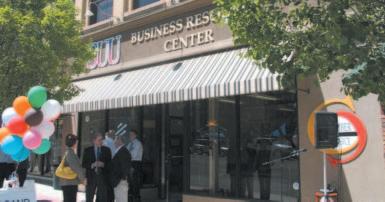
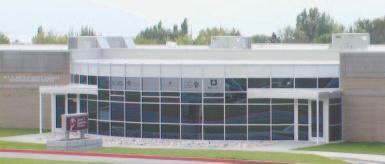
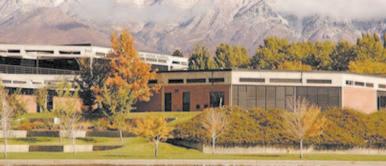
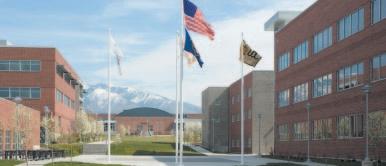
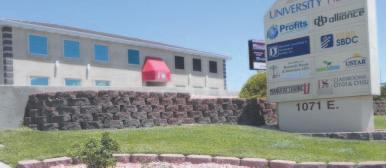
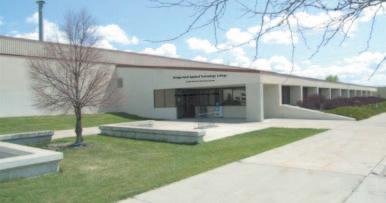
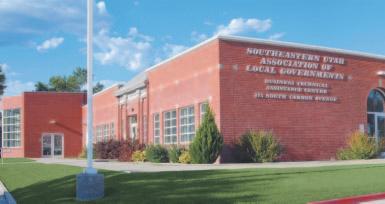
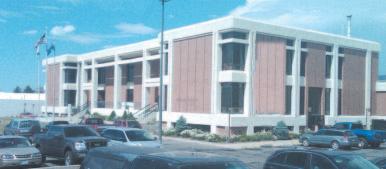
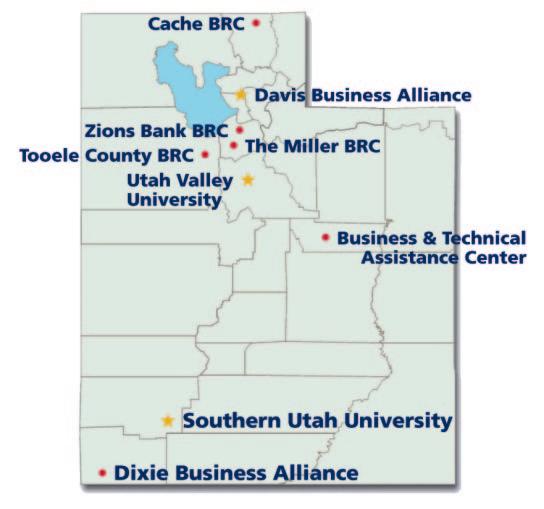
81 Governor’s Office of Economic Development
Annual Report 2010
www.business.utah.gov
•
•
Business Resource Center’s Contacts
Utah Procurement Technical Assistance Centers
for SALT LAKE AND SUMMIT COUNTIES
MAIN OFFICE
Utah Procurement Technical Assistance Center
CONTACT: Fred Lange, Director – 801.538-8733
EMAIL: fglange@utah.gov
Chuck Spence, Deputy Director – 801.538-8655
EMAIL: cspence@utah.gov
324 South State Street, Suite #500
Salt Lake City, UT 84111
FAX: 801.538-8888
Program Web Address: www.goed.utah.gov/PTAC
for SOUTH SALT LAKE, AND TOOELE COUNTIES
SALT LAKE COMMUNITY COLLEGE
CONTACT: Jonnie Wilkinson – Regional Manager
SLCC / Larry Miller Campus
9750 South 300 West, MCPC
Sandy, UT 84070
OFFICE
PH: 801.957.6076
CELL: 801.867-9287
FAX: 801.957-3488
EMAIL: jwilkinson@utah.gov
for UTAH, WASATCH, JUAB, SANPETE, MILLARD, DUCHESNE, UINTAH, AND DAGGETT COUNTIES
UTAH VALLEY UNIVERSITY
CONTACT: Cory Holley – Regional Manager
1410 West 1200 South
Orem, UT 84058-5999
PH: 801.863-8713
FAX: 801.863-7071
CELL: 801.830-9088
EMAIL: cholley@utah.gov
for DAVIS, WEBER AND MORGAN COUNTIES
DAVIS APPLIED TECHNOLOGY
COLLEGE
Contact: Sharon Young – Regional Manager
DATC/Davis Business Alliance
450 South Simmons Way, Suite #300
Kaysville, UT 84037
PH: 801.593-2242
FAX: 801.593-2110
CELL: 801.755-5146
EMAIL: sayoung@utah.gov
for BOX ELDER, CACHE AND RICH COUNTIES
BEAR RIVER ASSOCIATION OF GOVERNMENTS
CONTACT: Cindy Roberts – Regional Manager
Cache Business Resource Center
BATC West Campus
1410 North 1000 West, Rms 1901-1905
Logan, UT 84341
OFFICE PH: 435.213-8713
FAX: 435.753-5709
EMAIL: croberts@cachebrc.com
for CARBON, EMERY, GRAND & SAN JUAN COUNTIES
SOUTHEASTERN UTAH ASSOCIATION OF GOVERNMENTS
CONTACT: Delia Paletta
375 South Carbon Avenue, Price UT 84501
PH: 435. 637-5444 Ext.408
FAX: 435.637-7336
EMAIL: dpaletta@seualg.utah.gov
Or
CONTACT: Cory Holley – Regional Manager
1410 West 1200 South, Orem, UT 84058-5999
PH: 801.863-8713; Cell: 801.830-9088
EMAIL: cholley@utah.gov
for IRON, BEAVER, PIUTE, WAYNE AND SEVIER COUNTIES
SUU SMALL BUSINESS DEVELOPMENT CENTER PROCUREMENT TECHNICAL
ASSISTANCE CENTER
Craig Isom – Director
PH: 435.586-4087; EMAIL: isom@suu.edu
Contact: Joni Anderson
77 North Main Street, Cedar City, UT 84720
PH: 435.586-8883
FAX: 435.586-4310
EMAIL: andersonjoni@suu.edu
for WASHINGTON, KANE AND GARFIELD COUNTIES
DIXIE STATE COLLEGE OF UTAH
Dixie Business Alliance
CONTACT: Keith Christiansen – Regional Manager
1071 East 100 South, Suite #C7
St. George, UT 84770
PH: 435.652-7754
CELL: 435.229-1846
FAX: 435.652-7870
EMAIL: keithchristiansen@utah.gov
82 Governor’s Office of Economic Development • Annual Report 2010 • www.business.utah.gov
Economic
Development
Contacts by County
Beaver
Beaver County Economic Development
330 S. Main
P.O. Box 511
Beaver, UT 84713 (435) 438-6482
www.beavercountyutah.com
Box Elder
Box Elder County Economic Development
1 S. Main Street 3rd floor
Brigham City, UT 84302 (435) 734-3397
www.boxelder.org
Cache
Cache Valley Chamber of Commerce
160 N. Main Street Room 102
Logan, UT 84321 (435) 752-2161
www.cachechamber.com
Carbon
Carbon County Future
120 E. Main St.
Price, UT 84501 (435) 636-3295
www.carbon.utah.gov/econdev
Daggett
Daggett County Economic Development
95 N. 100 W.
Manila, UT 84046 (435) 784-3218
www.daggettcounty.org
Davis
Davis County Economic Development
28 E. State Street Room 221
Farmington, UT 84025 (801) 451-3278
www.daviscountyutah.gov
Duchesne
Duchesne County Economic Development
50 E. 200 S.
Roosevelt, UT 84066 (435) 722-4598
www.duchesne.net
Emery
Emery County Economic Development
95 E. Main Street #107
Castle Dale, UT 84513 (435) 381-5576
www.emerycounty.com
Garfield
Garfield County Economic Development
55 South Main Street
Panguitch, UT 84759 (435) 676-1157
www.garfield.utah.gov
Grand
Grand County Economic Development
125 E. Center Street
Moab, UT 84532 (435) 259-5121
www.grandcountyutah.net
Iron
Iron County Economic Development
10 N. Main Street
Cedar City, UT 84720 (435) 586-2770
www.cedarcity.org
Juab
Juab County
Economic Development Agency
160 N. Main Street, Rm. 102
Nephi, UT 84648 (435) 623-3415
www.co.juab.ut.us
Kane
Kane County Economic Development
76 N. Main
Kanab, UT 84741 (435) 644-4900
www.kane.utah.gov
Millard
Millard County Economic Development Association
71 S. 200 W.
Delta, UT 84624 (435) 864-1407
www.millardcounty-ecdev.com
83 Governor’s Office of Economic Development • Annual Report 2010 • www.business.utah.gov
Economic Development
Contacts by County
Morgan
Morgan County Economic Development
48 W. Young St.
Morgan, UT 84050 (801) 845-4065
www.morgan-county.net
Piute
Piute County Economic Development
550 N. Main Street Junction, UT 84740 (435) 577-2949
www.piute.org
Rich
Rich County–Bear Lake Regional Commission
69 N. Paradise Pkwy
Garden City, UT 84028 (435) 946-2198
www.richcountyut.org
Salt Lake
Salt Lake County Economic Development
2001 S. State Street
Suite S2100
Salt Lake City, UT 84190 (801) 468-2221
www.co.slc.ut.us
San Juan
San Juan County Economic Development
117 S. Main Street
Monticello, UT 84535 (435) 587-3235 ext. 4138
www.utahscanyoncountry.com
Sanpete
Sanpete County Economic Development Association
191 N. Main Street
Manti, UT 84642 (435) 835-4321
www.sanpete.com
Sevier
Sevier County Economic Development
250 N. Main Street, Room 10
Richfield, UT 84701 (435) 893-0454
www.sevierutah.net
Summit
Summit County Economic Development
1910 Prospector Ave., Suite 103
Park City, UT 84060 (435) 649-6100
www.parkcityinfo.com
Tooele
Tooele County Economic Development
47 S. Main Street, Tooele, UT 84074 (435) 843-3160
www.tooeleeconomicdevelopment.com
Uintah
Uintah County Economic Development
1680 W. Hwy. 40
Vernal, UT 84078 (435) 722-1766
www.co.uintah.ut.us
Utah
Utah County Business Development
34 E. 1700 S. OSTC Bldg., Provo, UT 84601 (801) 420-9109
www.edcutah.org/uc
Wasatch
Wasatch County Economic Development
475 N. Main Street
Heber City, Utah 84032 (435) 654-3666
www.hebervalleycc.org
Washington
Washington County Economic Development Council
225 S. 700 E., St. George, UT 84770 (435) 652-7750
www.dixiebusinessalliance.com
Wayne
Wayne County Economic Development
18 South Main, Loa, UT 84747 (435) 836-1315
www.waynecountyutah.org
Weber
Weber Chamber of Commerce
2484 Washington Blvd., Suite 400
Ogden, UT 84401
(801) 621-8300 ext. 3013
www.webergrowth.com/home.html
84 Governor’s Office of Economic Development • Annual Report 2010 • www.business.utah.gov
Governor’s Office of Economic Development Contacts
GOED Administration
Spencer Eccles Executive Director
Clark Caras Director of Marketing 801-538-8698 chcaras@utah.gov
Michael Sullivan Director of Communications 801-538-8811 mgsullivan@utah.gov
Sophia DiCaro Goodick Finance Manager 801-538-8823 sdicaro@utah.gov
Leela Beaudry Accounting Specialist 801-538-1374 lbeaudry@utah.gov
Dustin Salisbury Financial Analyst 801-538-8819 dustinsalisbury@utah.gov
Sue Redington Assistant to Executive Director 801-538-8769 sredington@utah.gov
Greg Slater Marketing Communication Specialist 801-538-8684 gregslater@utah.gov
Business Creation
Gary Harter Managing Director 801-538-8784 gharter@utah.gov
Marshall Wright Director of Business Development 801-538-8710 mnwright@utah.gov
Dr. Tami Goetz State Science Advisor 801-538-8871 tgoetz@utah.gov
Dottie Henderson
Administrative Assistant 801-538-8749
djhenderson@utah.gov
Riley Cutler Director of Outdoor Products Cluster 801-538-8873 crcutler@utah.gov
Samantha Mary Julian Energy and Natural Resources Cluster Director 801-538-8746 sjulian@utah.gov
Yashoda Khandkar Special Advisor, UGREEN 801-580-6519 ykhandkar@utah.gov
Corporate Recruitment and Incentives
Derek Miller Managing Director 801-538-8828
Christina Oliver Incentives Manager 801-538-8792 coliver@utah.gov
Tamy Dayley Senior Financial Analyst 801-538-8860 tdayley@utah.gov
Amy Hamblin Administrative Assistant 801-538-8828 ahamblin@utah.gov
Greg Hartley Project Manager 801-538-8743 ghartley@utah.gov
Christine Broadbent Program Specialist 801-538-8825 cbroadbent@utah.gov
Kelsy Alsup Intern 801-538-8672
kalsup@utah.gov
Aaron White Intern 801-538-8825 ajwhite@utah.gov
Tara Thue Broadband Mapping and Planning Coordinator 801-541-3473 tthue@utah.gov
Ashley Anderson Intern 801-538-8703 ananderson@utah.gov
Centers of Excellence
Nicole Toomey Davis Director 801-538-8687 ndavis@utah.gov
Sharon Cox Program Coordinator 801-538-8770 scox@utah.gov
Office of Rural Development
Les Prall Rural Development 801-538-8804 lprall@utah.gov
Beverly Evans Rural Development 801-538-8638 bevans@utah.gov
Procurement Technical Assistance Center (PTAC)
Mr. Fred Lange Director 801-538-8733 fglange@utah.gov
Chuck Spence Deputy Director 801-538-8655 cspence@utah.gov
Myrna Hill Administrative Assistant 801-538-8775 myrnahill@utah.gov
85 Governor’s Office of Economic Development • Annual Report 2010 • www.business.utah.gov
Governor’s Office of Economic Development Contacts
Jonnie Wilkinson Regional Manager Salt Lake & Tooele Counties 801-957-6076 jwilkinson@utah.gov
Cory Holley Regional Manager Utah & Wasatch Counties 801-863-8713 cholley@utah.gov
Sharon Young Regional Manager 801-593-2242 sayoung@utah.gov
Office of Consumer Health Services
Matthew Spencer Program Manager 801-696-4506 mspencer@utah.gov
Brandon Bowen Compliance Manager bbowen@utah.gov
Sue Watson Project Manager 801-209-8290 spwatson@utah.gov
International Trade and Diplomacy
Craig Peterson Program Director 801-538-8778 cepeterson@utah.gov
Miguel Rovira Regional Director – Americas 801-538-8885 mrovira@utah.gov
Franz Kolb Regional Director – Europe 801-538-8717 fkolb@utah.gov
Brett Heimburger Regional Director – Asia 801-538-8651 bheimburger@utah.gov
Diana Franca Intern 801-538-8714 dfranca@utah.gov
Adam Walden
International Trade and Hosting Coordinator 801-538-8737 awalden@utah.gov
Janice Kopaunik Intern jkopaunik@utah.gov
Pete Suazo Utah Athletic Commission
Bill Colbert Commission Director 801-538-8876 bcolbert@utah.gov
Utah Office of Tourism
Leigh Von der Esch Managing Director 801-538-1370 lvondere@utah.gov
Tracie Cayford Deputy Director 801-538-8777 traciec@utah.gov
Dave Williams Deputy Director 801-538-1317 dmwilliams@utah.gov
Barbara Bloedorn Assistant to Director 801-538-1369 bbloedorn@utah.gov
Clayton Scrivner Media Relations 801-538-1759 cscrivner@utah.gov
Patti Denny Manager Travel Trade Program 801-538-1318 pdenny@utah.gov
Rebecca Katz Travel Trade Coordinator 801-538-1479 rkatz@utah.gov
Dave Hansford Visitor Services 801-538-1367 dhansford@utah.gov
Lorraine Daly Marketing Assistant 801-538-1306 ldaly@utah.gov
Dominic Brown Travel Trade Specialist 801-538-1373 dcbrown@utah.gov
Kelly Day Web & Cooperative Marketing Manager 801-538-1727 kday@utah.gov
Jim Buchanan Research Coordinator 801-538-1375 jbuchanan@utah.gov
Chad Davis Special Projects Manager 801-538-1422 chaddavis@utah.gov
Utah Film Commission
Marshall Moore Director 801-538-1377 mdmoore@utah.gov
Mimi Davis-Taylor Producer Services Executive 801-538-1371 mdtaylor@utah.gov
Trevor Snarr Communication Specialist 801-538-1307 tgsnarr@utah.gov
Ricardo Flores Marketing and Creative Executive 801-538-1379 rcflores@utah.gov
Derek Mellus Producer Services Executive 801-538-1120 Dmellus@utah.gov
Tammy Villa-Humphreys Executive Secretary 801-538-1332 tvilla@utah.gov
86 Governor’s Office of Economic Development • Annual Report 2010 • www.business.utah.gov
87 Governor’s Office of Economic Development • Annual Report 2010 • www.business.utah.gov GOED Organizational Chart CREATE Spencer Eccles Executive Director Gary Harter Managing Director Derek Miller Managing Director Centers of Excellence Economic Clusters Business Resource Centers Pr ocurement T echnical Assistance Centers Rural Development Corporate Recruitment & Incentives Ma rk eting & Research Utah Film Co mmission Communications and Fulfillment Web Management & Research Producer Services Media Relations & Travel Trade Publications International Trade & Diplomacy Director State Science Advisor Leigh von der Esch Managing Director Pe te Suazo Utah At hletic Co mmission Office of C onsumer Health Services Broadband Mapping and Planning GROW PROMOTE Aerospace & Defense Energy & Natural Resour ces Financial Services Li fe Sciences Outdoor Products & Recreation Software Development & Information Technology Scenic Byways Cooperative Mark eting ASSOCIATED PROGRAMS Resource Directory / Web Services
GOED Management Team

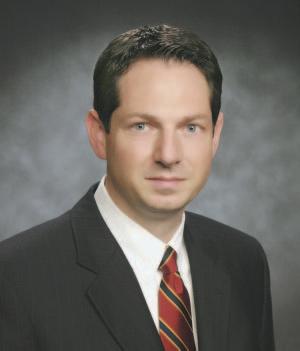
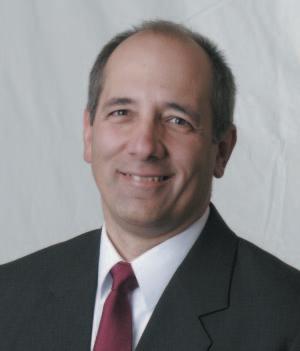
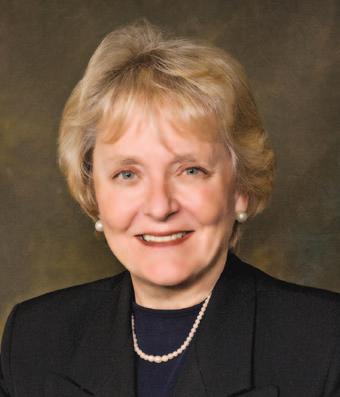
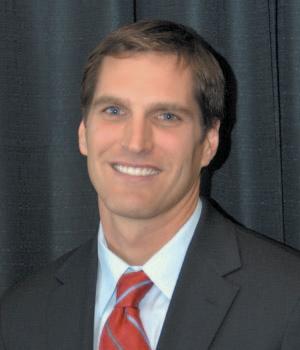
Spencer Eccles, Executive Director
Spencer Peterson Eccles has strong ties to Utah’s urban and rural communities as well as international markets. He was formerly affiliated with the 2002 Winter Olympics and with the Salt Lake City office of Wells Capital Management (Wells Fargo Bank). Most recently, he has been involved with emerging web-based software and materials technology companies in the U.S. and abroad.
Eccles’ involvement with Utah’s non-profit community includes his past chairmanship of the Salt Lake Chamber’s International Committee and service on its Board of Governors and Executive Committee. He serves as president of the First Security Foundation, and advises with The George S. and Dolores Doré Eccles Foundation. At the University of Utah, he is a member of the advisory boards of the Tanner Humanities Center’s World Leaders Lecture Forum and the David Eccles School of Business.
Derek Miller, Deputy Director
Derek Miller is GOED Deputy Director and manages the Business Incentives and Growth programs. In this capacity Mr. Miller oversees the International Trade and Diplomacy Office, the Office of Rural Development, and the Corporate Recruitment Team.
Prior to this appointment, Mr. Miller served as the Director for the Utah Division of Real Estate. Mr. Miller has also served as congressional Counsel for the Transportation and Infrastructure Committee in the U.S. House of Representatives. Prior to his position with the United States Congress Mr. Miller was a management consultant with Arthur Andersen, LLP.
Gary Harter, Managing Director
Gary is Managing Director for the Business Creation Team which includes the Utah Clusters Initiative, Centers of Excellence Program, Business Resource Centers, Procurement Technical Assistance Center and State Science Advisor. Prior to these duties Gary was the Defense and Homeland Security Cluster Director in the office. Gary is a retired Army Colonel who spent 25 years on active duty, whose final assignment was as Commander, U.S. Army Dugway Proving Ground.
Leigh von der Esch, Managing Director
Leigh is the Managing Director of the Utah Office of Tourism, which also includes the Utah Film Commission. Leigh was the Utah Film Commissioner for 20 years, and also served as Chief Administrative Officer for the Department of Community and Economic Development. Prior positions included Business and Post Production Coordinator for a motion picture company, Executive Director of the Salt Lake City Council and Legislative Assistant to a U.S. Congressman.
Josh Romney, Policy Advisor
Josh Romney is the founder of Romney Ventures, which invests in real estate, oil and mineral assets. This Salt Lake City based company actively pursues distressed asset and debt opportunities throughout the U.S.
Josh worked on his father’s Presidential campaign from 2006 to 2008 performing a variety of roles. He helped manage campaign events and strategy for the Intermountain West states and promoted fundraising efforts in those states.
Josh currently serves as an advisory board member for the Deseret International Foundation, which partners with local doctors in an effort to establish permanent and sustainable healthcare in developing countries.
88 Governor’s Office of Economic Development • Annual Report 2010 • www.business.utah.gov
“Utah’s

economic climate is safe, solid
positioned
grow.”
Governor Gary R. Herbert 324 S. State Street, 5th Floor Salt Lake City, UT 84111 801-538-8700 www.business.utah.gov
and
to
–
































































































































